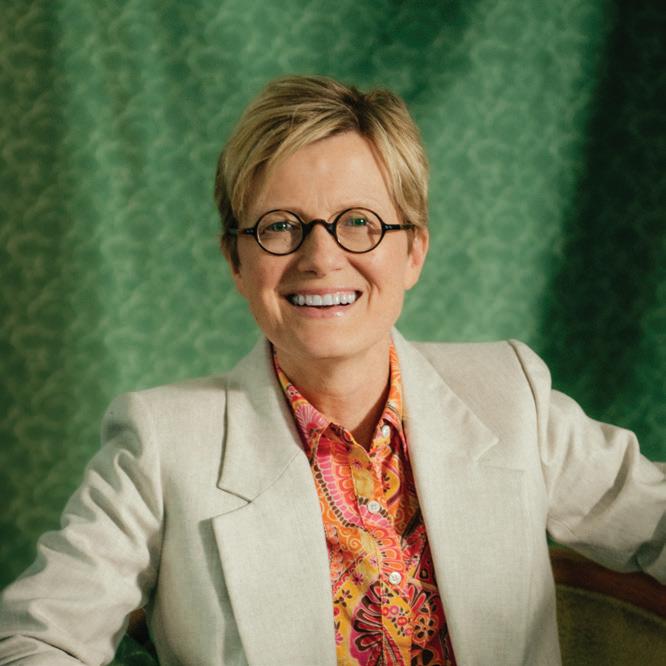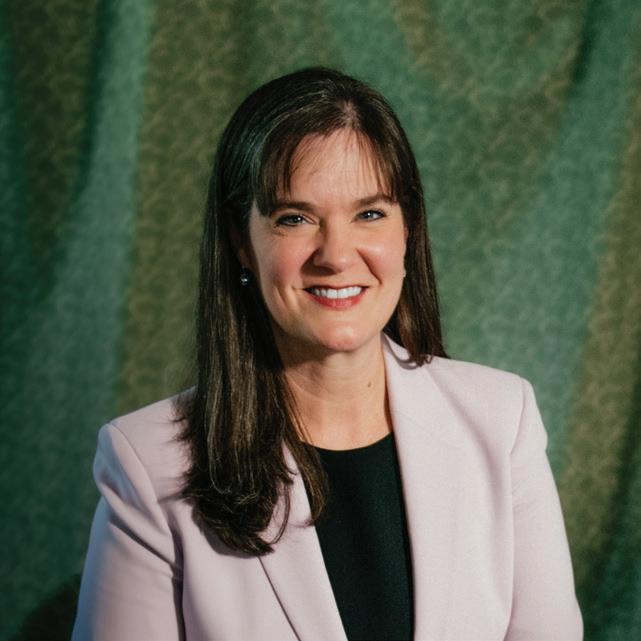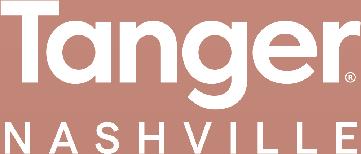












It’s what brings focused excellence in workforce management, health care, and life sciences, coupled with powerful litigation and transactional strategies. And it’s how we provide complete client solutions, partner with your in-house team, and create value.

Epstein Becker Green (EBG) brings over 50 years of experience in health care and employment law to businesses in Nashville and greater Tennessee. Backed by its roots in New York and Washington, DC, our team comprises a diversified network of attorneys who pair their experience and relationships to create tailored legal solutions.
In the intricate world of health care and life sciences, having a legal partner who understands the regulatory landscape is crucial. At EBG, our team includes a wealth of professionals—many with governmental and direct in-house experience—who provide proactive insights into regulatory work.

Howard T. Wall, Of Counsel, states, “EBG possesses a depth of knowledge and practical solutions that are essential for navigating the complex legal landscape of health care and life sciences.”
We’re not just advisors; we’re collaborators who help you unlock growth with creative solutions that meet the specific needs of Nashville’s dynamic health care environment.
Navigating the evolving landscape of labor and employment law can be daunting. EBG is committed to helping businesses in Nashville stay compliant and proactive. Our team ensures that you receive informed guidance on regulations that impact your workforce.
John C. Tishler, Member of the Firm, emphasizes, “Our direct connection to and deep relationships in Washington, DC, allows us to provide our clients with valuable insights into a large swath of regulations—especially within labor and employment—that enable them to make informed decisions that mitigate risks.”
Now more than ever, no organization is immune to the threat of legal disputes. At EBG, we help companies of all sizes and at all stages of maturity handle litigation as a business challenge rather than a major distraction. Whether enforcing rights through aggressive prosecution, responding to complaints, or defending against formal claims, we develop resultsoriented strategies that protect our clients’ interests without upending their business goals.
Founded in 1973, EBG is a national law firm primarily focused on health care and life sciences, labor and employment, and litigation and business disputes. We serve domestic and multinational clients—from startups to Fortune 100 companies—across various industries. Operating in locations throughout the United States, our attorneys are committed to uncompromising client service and legal excellence.
Epstein Becker Green 1222 Demonbreun Street Suite 1400 Nashville, TN 37203 615-564-6060
Website: www.ebglaw.com
Subscribe for email notifications and follow us on LinkedIn, Facebook, X, Instagram, and YouTube.
Number of Locations: 21
Combining our national resources with our local experience, we provide homegrown Nashville businesses, U.S. and international companies, and investors in the health care and information technology industries with innovative legal solutions, strategic business advice, and effective litigation services.

After
The
For the past two decades, Nashville has grown to an almost unrecognizable size in the downtown area. It seems construction of a high-rise building is completed every few months.
The city has boomed with the health care industry adding hundreds of jobs. Tech jobs are continuing to increase, too, and the entertainment industry keeps the music in Music City.
But the growth in Nashville’s epicenter may have been outpaced by the city’s neighborhoods. We know how downtown has changed, but in these pages, we look at how the pockets of the city are experiencing growth in business and lifestyle that was unimaginable before this century began.
Boom 2024 is all about those neighborhoods and the businesses that are a part of them. We’ve taken a step back from our daily reporting to dive deeply into what’s happening as new businesses are moving in or long-standing businesses are getting a facelift. We look at the renewal in the neighborhoods and how we can live, work and play in the same place.
We visit the continuing renewal of Second Avenue, one of the city’s longtime entertainment hangouts (page 10). We talk about the high-end shopping that has moved into 12South and Green Hills (page 22). We look at how business is coming to Germantown’s Neuho (page 10), how The Nations continues to transform (page 8), how cafes are reshaping Wedgewood-Houston and how the Global Mall is finally starting to take shape (page 8). We explore the business behind the celebrity bars that dominate downtown (page 14) and how luxury hotels are becoming more widespread (page 18).
Now, if you’re reading this and are not subscribing to our news website, you’re missing the daily updates on property buys and sells, the personnel moves and deals that are helping our city grow.
Please join us at nashvillepost.com as we keep you up to date on everything happening in the business world.
Kevin Spain, Editor


On the cover
editorial
EDITOR
Kevin Spain
MANAGING EDITOR
William Williams
STAFF WRITERS
Logan Butts, Hannah Herner, Nicolle S. Praino
CONTRIBUTING WRITERS
Lena Anthony, Caitlin Burke, Margaret Littman
art & production
ART DIRECTOR
Mary Louise Meadors
STAFF PHOTOGRAPHERS
Angelina Castillo, Eric England, Hamilton Matthew Masters
GRAPHIC DESIGNERS
Sandi Harrison, Tracey Starck
PRODUCTION COORDINATOR
Christie Passarello
publishing
PUBLISHER
Heather Cantrell Mullins
SENIOR ADVERTISING SOLUTIONS
MANAGERS
Teresa Birdsong, Carla Mathis, Niki Tyree
ADVERTISING SOLUTIONS MANAGERS
Maddy Fraiche, Kailey Idziak, Rena Ivanov, Allie Muirhead
SALES OPERATIONS MANAGER
Chelon Hill Hasty
ADVERTISING SOLUTIONS ASSOCIATES
Audry Houle, Jack Stejskal
events
EVENTS AND MARKETING DIRECTOR
Robin Fomusa
BRAND PARTNERSHIPS & EVENTS MANAGER
Alissa Wetzel
circulation
CIRCULATION &
SUBSCRIPTION DIRECTOR
Gary Minnis
business
PRESIDENT
Mike Smith
CHIEF FINANCIAL OFFICER
Todd Patton
CREATIVE DIRECTOR
Elizabeth Jones
IT DIRECTOR
John Schae er
SPECIAL PROJECTS COORDINATOR
Susan Torregrossa
FW Publishing, LLC
OWNER
Bill Freeman
615 Main St.
Nashville, TN 37206 nashvillepost.com
Nashville Post is published by FW Publishing, LLC.
Advertising deadline for the next issue is March 12. For advertising information, call Heather Cantrell Mullins at 615-844-9252. For subscription information, call 615-844-9307. Copyright © 2024 FW Publishing, LLC.

October 2024
Dear Chamber Member,
500
As a valued member of the Nashville Area Chamber, I am pleased to share with you that, as part of your membership benefits, you will be receiving the latest issue of Nashville Post Magazine. We’re proud to partner with FW Publishing, a trusted media partner of the Chamber, to bring you this publication, which highlights important developments and stories that impact our business community.
Thank you for your continued membership and support of the Chamber. Together, we are building a prosperous future for the Nashville region’s businesses and communities.
Warm regards,

Ralph Schulz President and CEO Nashville Area Chamber of Commerce
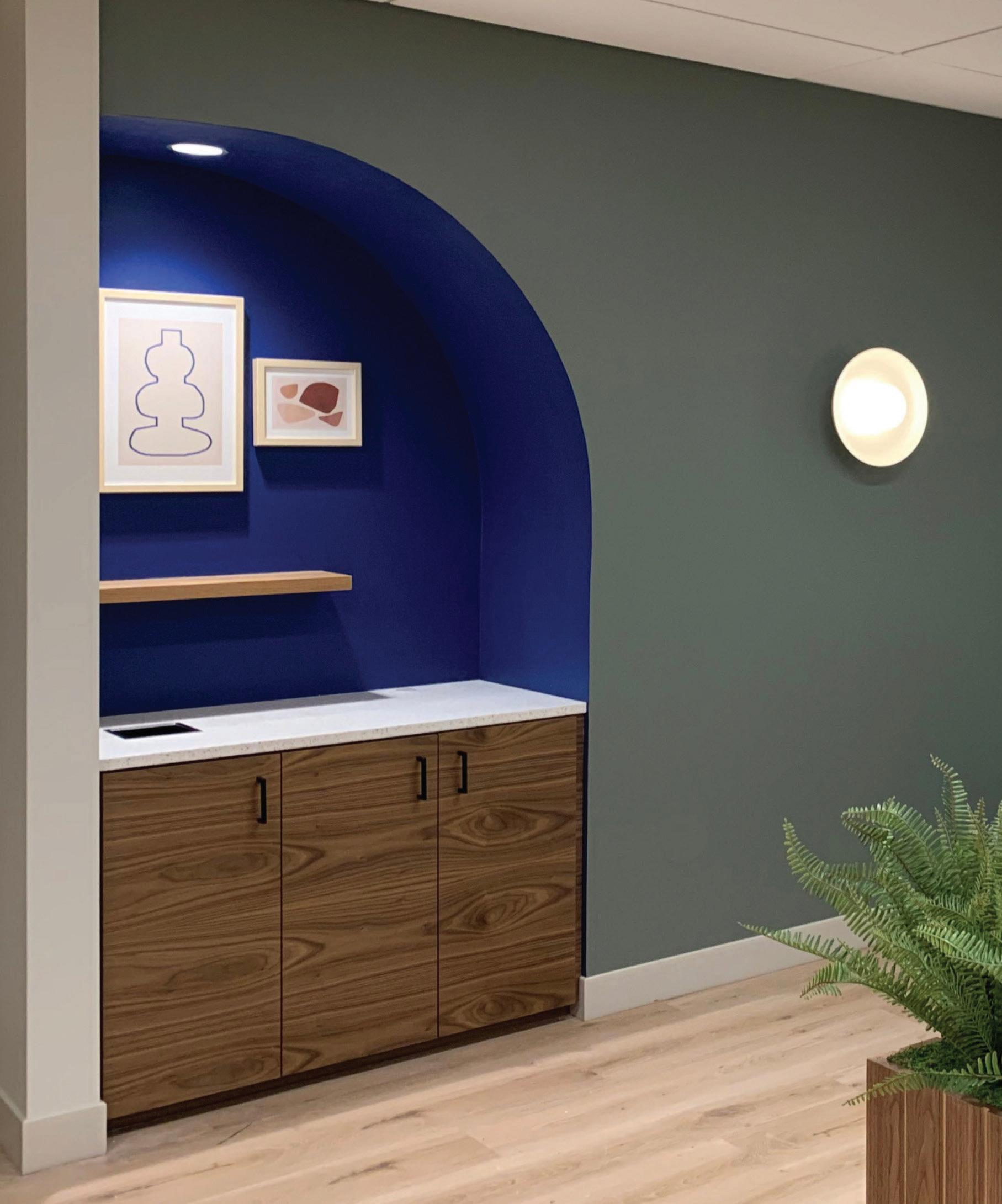

by Christine Rachelle
Vehicle-tracker sales need not bother Commercial Industrial Construction: this Nashville commercial general contractor doesn’t use trackers. Time clocks? No need: all jobs are visited by a roving superintendent and project managers. Issues with subcontractors? These are rare, as this company—also known as CIC—utilizes on-site supervision, meaning for large jobs, a superintendent will be on-site every workday. CIC never uses thirdparty estimators nor estimating software: project managers create estimates having put their eyes on a site and on plans. The most surprising trick of all? Commercial Industrial Construction’s exceptionally low turnover: in the past ten years, only three staff members have left for other positions.
How has CIC achieved these results without the technology that claims to prevent waste, track employees, or estimate costs? For CEO Jon English, the keys are training and trust. “I treat my employees like I’d want to be treated,” says the 35-year construction veteran. Having left a competing firm twenty years ago, he and business partner Tony Williams, CFO, started CIC in 2003 with a goal to reward employees for hard work, generating employee loyalty and pride.
Senior staff, some with more than 40 years’ experience, train their helpers on the job by passing on practical skills, and they have not been forced to learn ever-evolving software that might slow them down. Project managers train directly under English, who still does plan
take-offs by hand to identify potential problems and unusual circumstances. Experience creates accurate pricing; the team has seen estimation software used by others. make costly mistakes. Software also will not suggest alternatives to save a client time or money. As a result, many find that CIC’s budgets and bids fall in the middle when compared to the competition: not the highest, like those who would pad numbers to increase profit artificially, and not the lowest, like those who may try to “make up the difference” with change orders.
The resulting benefits for clients may surprise others in the construction industry. Projects usually finish on time, as project managers understand the job better, and field staff keep projects moving. If a subcontractor shows up late, changes teams, or brings the wrong materials, CIC’s on-site staff can report and help fix problems immediately. Field staff are on hand to meet Codes inspectors, and when shipments arrive, someone on-site will receive them and verify they are correct. Even during demolition, CIC can utilize deconstruction practices to preserve reusable materials that clients wish to save, such as millwork, doors and frames, lighting, and flooring. This not only reduces waste but also reduces costs—dumpsters are another cost driver in Nashville.
By resisting trends that shift every few years, Commercial Industrial Construction found it can provide one of the most valuable things of all in construction: consistency.

Commercial Industrial Construction, Inc., aka CIC, is a locally-owned commercial interiors contractor working throughout middle Tennessee. Founded with the idea that happy employees perform good work, CIC’s employees develop longterm relationships with clients to provide a positive construction experience for all involved.




Jon English CEO & Project Manager
Kenny Bundy Senior Project Manager
Denys Cochran Project Manager
Wenn Turner Project Manager
• Deconstruction
• Shell Space
• 2nd Generation Space
• Renovation / Remodeling
• Adaptive Reuse
• Value Engineering


A new phase of Nashville growth is shaping the face of the city once again. Neighborhoods are developing their own style of live-work-play, from Germantown and The Nations to Wedgewood-Houston and Antioch. Plus, high-amenity value-adds to office space and a growing talent pool are attracting businesses to the city, while luxury hotels are popping up everywhere as tourism soars — including with the success of celebrity concepts from hospitality brands. In these pages, we probe into the changes and what to expect in the future. AERIAL INNOVATIONS SOUTHEAST

Suburban refresh to prioritize transit, housing
BY NICOLLE S. PRAINO
One of Metro’s biggest redevelopment projects for 2024 is the 78-acre Global Mall area. It is yet another example of the city’s efforts to create communities in places that are growing with no sign of decreasing.
The master plan for the mall states: “The changing requirements of the global knowledge and innovation economy make it imperative for Nashville, in an effort to enhance its competitiveness, to refocus growth inward by adapting existing underused resources, such as the mall, into livable, vibrant, and environmentally sustainable urban places.”
Antioch’s population doubled between 2000 and 2020 to around 99,000 people and the demographics shifted to a more racially diverse group, according to the plan.
The market study showed 44 percent of the housing market is younger singles and childless couples. The study points to a strong demand for multifamily and market-rate housing in a mixed-use setting. The plan states that the full redevelopment capacity could fill up in less than 10 years.
“There’s definitely a proven track record of retrofitting suburban malls,” said Eric Hoke, design director for the Civic Design Center. “The ones that use strategies like transitoriented development are definitely the ones that at least I would point to … that’s the smart growth that I think we need, especially in these communities like Antioch that have just sprawled out for so long.”
The plan for the mall site considers transportation critical to the success of the redevelopment. The transit center the plan accounts for has already received funding through a federal grant to WeGo. In addition to the bus station and multi-family housing, the plan recommends retail and restaurant space, a theater, a day care center, office space, a hotel and cultural centers such as museums
or art galleries.
While the legislation to start the development process just received its final Metro Council approval in late August, there are several more steps before the site becomes the bustling community that the plans have in store.
Metro Planning has/will issue/d a request for proposals from developers who will then submit their plans to the city for how they will turn the planned vision into reality. Once Metro picks a master developer for the project, it will enter a period of contract negotiations. If this process sounds familiar, that’s because it’s the same thing the city just did with the Fallon Company on the East Bank. In the same way, the plan for the mall site notes the necessity of collaboration between Metro and nonprofit and private sector partners.
That cooperation will help create the public spaces and walkable infrastructure needed for the success of the development. The plan recommends Metro to continue multimodal and safety efforts for Bell Road and ensure a shared-use path on the perimeter to use as a connection to the regional trail system.
“If you just look at trends in urban development, the more walkable cities are the things that we’re still striving for,” Hoke said.
“We have this sort of moment in time, and I would say it’s really important that we get it right this time and now so that we’re not creating more problems for ourselves. I think we need this. We need Antioch to work and to sort of show us the way because there’s other suburban communities like this that could definitely benefit from this type of thing.”
Adding density to grow community
BY NICOLLE S. PRAINO
The Nations has been a developing neighborhood in Nashville since the early 2000s, and it continues to grow, with more rooftops and people every day.
“I think that’s the next step for The Nations is to attract more density,” Wood Caldwell of Southeast Venture says.
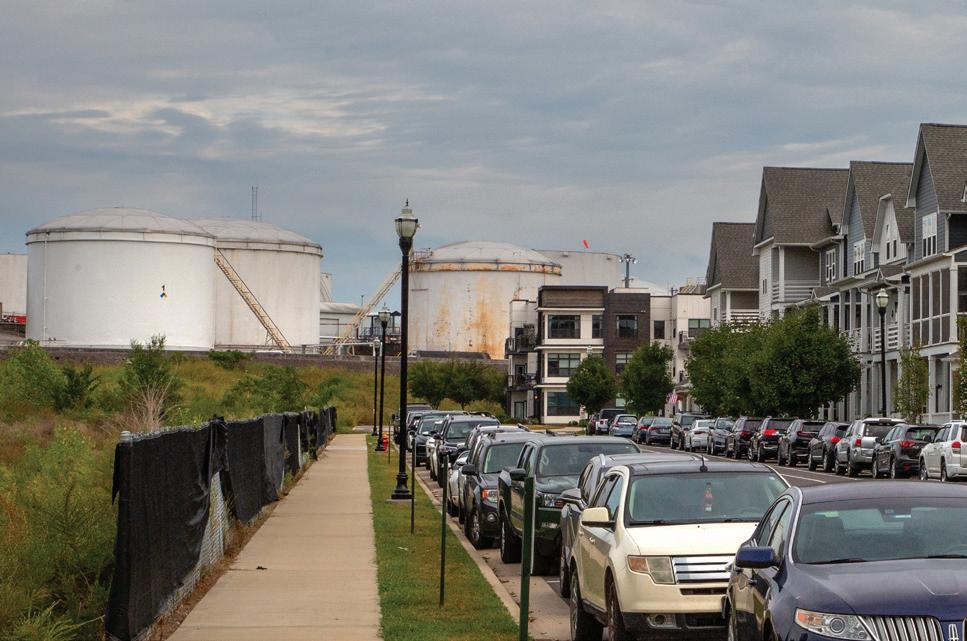
With one phase still to come of the company’s Silo Bend project that will be along the bluff of the river, that’s bound to continue. He says the company already has 200 units approved and is working on a change to the zoning to add 100 more units to that plan.
“You’ve got to get more residential in these areas so you can support the retail, and that’s what’s finally happening,” Caldwell says.
He says the first phase was “tall and skinny” single-family homes, and now as more developments like Silo Bend are being built, there are more opportunities for people to move into apartments and transition to condos or those homes as residents grow with the city and want to stay in The Nations.
“You’ve got to let this happen organically, but you’ve got to get more density, so people don’t have to get in their cars,” he says, adding that making an area more walkable is what attracts people to it.
“You can now walk from Silo on a sidewalk all the way to 51st, and when we first started developing, you couldn’t do that. You took your life in your own hands walking down Centennial,” he says.
Now though, connecting sidewalks is a priority in Mayor Freddie O’Connell’s proposed transportation plan that will be put to a vote in November. Caldwell says he supports the plan because it’s practical and while he realizes nothing happens overnight (the plan sets out 15 years of improvements) he looks forward to the changes it could bring to connect neighborhoods like The Nations.
Where the company is building now was once a brownfield, meaning it was previously industrial land that had environmental issues – Caldwell says the company worked through cleaning it up with approvals from the Tennessee Department of Environment and Conservation.
“Matter of fact, they were all for it because they were trying to turn over this old industrial property,” Caldwell says. “There were no buildings on this property when we bought it. We saw this and thought, ‘What an opportunity to be able to do some really cool stuff.’ Plus, you were right on the bluff of the river, which was very unique.”
He says where the Silo Bend project is

located there are gas tanks to the east, and many people originally thought development would be unable to thrive there. But Caldwell cites support for the development from former District 20 Metro Councilmember Mary Carolyn Roberts. Caldwell says what came along with that and truly set the tone for The Nations was the towering silo mural of Lee Estes.
“The whole idea was to bring [together] the older generations [who] still live in The Nations with the younger generations that are moving in – that’s what it symbolizes,” Caldwell says.
The mural was created as part of the Nashville Walls Project in 2017 by artist Guido van Helten, whose work can be found on buildings worldwide. Estes was 91 at the time when van Helten was doing research in the area for his art. Estes served at St. Luke’s Community House, providing food, child care and wraparound services for children, families and seniors. That gave van Helten the idea for the mural, which pictures Estes on one side of the silos and two children looking up toward him on the other side.
“The big mystery is – what goes on the other side of the silo?” Caldwell says, adding that the team has an idea for one part already. “On the right side, it’s already been determined what that’s going to be. We just don’t think the timing’s right yet, and Guido [van Helten] will come back.”
Opportunities and obstacles of development
BY CAITLIN BURKE
Nashville’s Wedgewood-Houston neighborhood has changed dramatically over recent years. Its reputation has shifted from a slower industrial district to “a creative hub on the cultural rise with artists and entrepreneurs opening art galleries, studios and workshops, restaurants, distilleries and breweries,”






according to the Nashville Convention & Visitors Corp. The area is home to o ces, cafes, storefronts and renters looking for a walkable apartment close to downtown.
Multiple developers have recently announced plans to expand in the neighborhood. Major players include Adventurous Journeys Capital Partners (AJ Capital), with ambitious plans to redefine the area over the next few years across 18 acres. The project will unfold in three phases, o ering retail, restaurant, residential and o ce spaces, reported Post writer William Williams in February.
The area is appetizing for several reasons on paper. But because of an onslaught of growth just this year, it’s been increasingly di cult for people who work in WedgewoodHouston to navigate driving and parking on one-way roads that might be closed o for construction. Cranes and forklifts are loud and always present. What was once a free parking lot is now enforced pay-per-hour.
One of the many businesses navigating growth is Fait La Force Brewing, a local brewery and taproom that opened in 2022. Co-owner Parker Loudermilk spoke with the Nashville Post on his perspective of the changing area.
“We chose WeHo for a couple of reasons,” Loudermilk says. “First, co-owners Zach and I both live south of town, so it is the neighborhood of Nashville we most frequently visited. Also, knowing that we were opening a European-focused brewery, we thought being near the incoming soccer stadium would be a great fit. We imagined that with the new stadium would come lots of growth to the area, and that would allow us to grow alongside the community,” Loudermilk adds.
Aside from the incoming stadium, the area was comparatively undeveloped three years ago.
“We are on the dead end of Third Avenue, and when we were signing our lease our street was mostly vacant warehouse space. While Second and Fourth Avenues both saw lots of tra c in and out of town, our little area was a bit of a ghost town,” he says.
Regarding the financial impact the growth
has made on his business, Loudermilk says it's a slower roll in seeing anything significant.
“Because we are on the fringes of the neighborhood, we haven't quite seen the benefits of the growth yet, other than from Geodis Park. Every home match day or before concerts, we typically get a really great crowd. But the rapid growth in residences and o ce space is quickly making its way to our side of the tracks, and we expect to begin seeing benefits early next year,” he adds.
As always with growth, locals are impacted positively and negatively; one downside has been the customer experience.
“The biggest thing we are dealing with currently is the construction in the area. Constant street closures, noise and construction mess have made it di cult for customers to navigate the neighborhood, and I imagine it’s dissuading people from visiting in its current state. While we think the result will be great, the current state of mass construction is hurting local businesses short-term,” he says.
To navigate the growth, Loudermilk had to identify what consumers in the area were missing, then decided to fill that niche.
“The only change we made anticipating new residents in the neighborhood was the addition of JamBox Sandwich Shop to our taproom. Previously, Clawson's Deli was a neighborhood favorite spot and one of the only neighborhood lunch spots along with Gabby's. With the addition of JamBox to the taproom, we hope to provide a new neighborhood lunch spot for meetings or just a quick tasty bite,” he adds.
Loudermilk shares a prediction that resonates with many Nashvillians contemplating the future of the city.
“I think there is going to be continued growth in the neighborhood throughout the next 10 years. Longtime Nashvillians have seen these changes to neighborhoods like Melrose, the Gulch, Germantown. I imagine Wedgewood-Houston is in the process of being added to that list. WeHo is rapidly transforming into a destination neighborhood in Nashville to live, work and play, and I think we are going to see continued development,” he says.
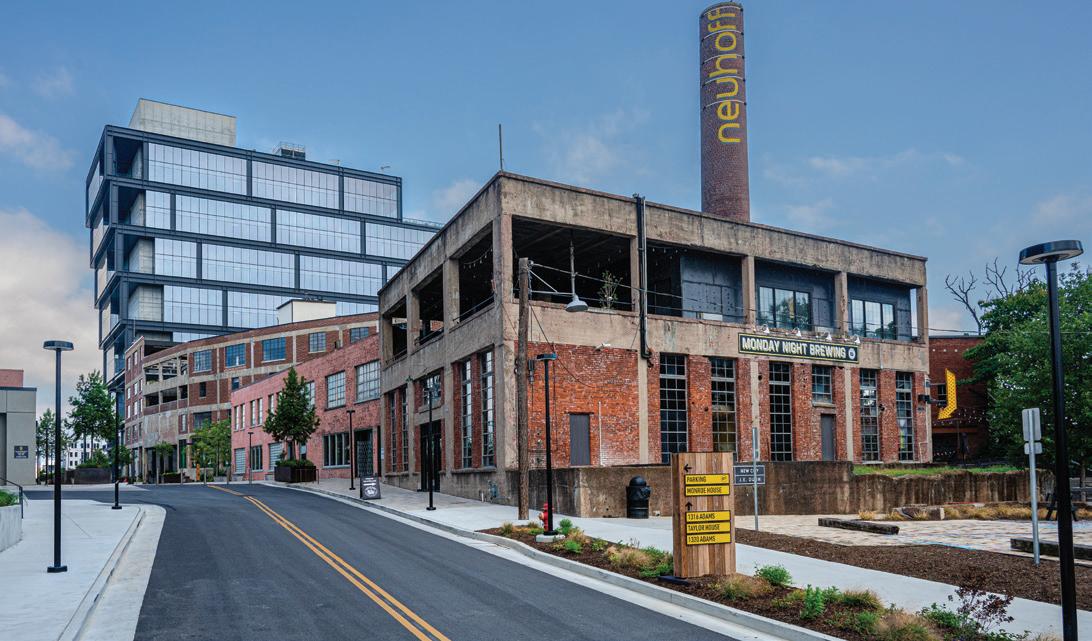
Germantown industrial space embraces live-work culture
BY NICOLLE S. PRAINO
The former Neuhoff Packing Co. property has become the centerpiece of Germantown’s new identity as a live-work environment, thanks to developer Jim Irwin and his Atlanta-based company New City Properties.
Irwin purchased the 14-acre property in 2020 for $32 million and worked with local architects from Smith Gee Studio to transform it into an amenity-packed office, residential and retail development.
This isn’t Irwin’s first rodeo using the culture of mixed-use development to establish a community within a neighborhood district of a larger city. He previously worked for Atlanta-based company Jamestown and helped oversee the project that transformed the former Sears, Roebuck & Co. distribution center into Ponce City Market.
The Neuhoff complex is just the beginning for Germantown’s continued development within Nashville’s larger period of growth. In February 2020 and July 2023, Pennsylvaniabased Toll Brothers Apartment Living bought nearby properties for $7.7 million with plans for a two-building apartment complex to have more than 300 residences. There is no date for a groundbreaking just yet but an amendment to the specific zoning plan was just approved by the Metro Planning Commission in late August.
Apart from residences in the area, Neuhoff quickly became a sought-after office district. In June 2023, Dalton Agency became the first business to sign on and moved from its office in East Nashville into the former meat-packing district. Then came the announcement that Rubicon Founders, a health care investment company, signed a lease for 16,000 square feet. Law firm Butler Snow followed, announcing a lease for the top two floors of the office tower. Accounting firm Frazier & Deeter announced plans in July to move its SoBro office to 29,000 square feet of the

Germantown redevelopment. The most recent announcement was from business consulting firm Boston Consulting Group, which will relocate to the Germantown office tower from Nashville’s central business district.
High-end retail has just begun to enter the district, with Atlanta-based boutique Mashburn being the first retailer to announce its move into a Neuhoff space, set to open this fall. Some restaurants have announced plans for the district including fast casual health food restaurant E+Rose and Atlanta-based Southern seafood concept Fishmonger.
The redevelopment of the former meatpacking district into this highly amenitized space is yet another example of Nashville neighborhoods coming into their own as more people and businesses invest in each of these areas.
Expect new businesses and a push for outdoor dining
BY HANNAH HERNER
It seems Second Avenue North is on the home stretch of the long recovery following the 2020 Christmas Day bombing, which devastated many of its historic structures.
Every few weeks, there’s an update. In June, the street and sidewalks of the first of three blocks were finished. California burger chain Mel’s Drive-In announced it would open its first location outside the state in the former B.B. King’s space in August. Pete’s Dueling Piano Bar joined in later. The building that formerly housed the beloved Old Spaghetti Factory was sold for $17.5 million shortly after, with plans for shortterm rental units and space left for retail or a restaurant. By the time this story goes to press, there will likely be more to add to the news — perhaps in the form of developments involving some of the most heavily bomb-damaged buildings or the former Hooters space.
Businesses notwithstanding, street construction is slated to be completed by the end of 2025, as estimated by the Metro
Development and Housing Agency’s urban development arm.
The Nashville Downtown Partnership introduced “Turn the Corner,” a campaign to keep tourists engaged in Second Avenue businesses as street construction stretches on.
“The street looks different every couple of weeks because they have to focus on a different part of the construction project, so it’s just staying on top of what their needs are for each phase of that,” says Crissy Cassetty, director of economic development at the Nashville Downtown Partnership.
For Second Avenue, an important metric is Broadway capture. How many people are turning the corner, as the partnership’s hotpink campaign suggests they should do? The organization has added people passing out flyers on weeknights to up the ante.
Second Avenue is getting about 14 percent of Broadway traffic. Before the barricades went up in 2023, the average was about 24 percent. Before the bomb hit, the Broadway capture average was about 30 percent.
When the street construction is over, Cassetty hopes the street will come back in a big way, with the addition of street dining.
“My goal would be to have outdoor dining options all along Second Avenue when that construction is complete next spring, but that also involves getting the actual merchants to want to do that,” she says. “There aren’t a ton of streets that you’re able to do a dining piece on. To have a complete streetscape plan done in a way that has the sidewalk dining piece in mind is a great thing.”
The wider and treeless sidewalks set the stage. However, before dining can happen, a trash study led by The District must be completed so it can be done without stink.
In the meantime, the Downtown Partnership maintains that it wants to see locals take part in what Second Avenue has to offer. Perhaps the percentage of patronage could match the 70 percent of the businesses there that are locally owned.
“I think Nashville is a city that invests in itself in more ways than one, and the more Nashvillians that we can get downtown to support these businesses during this time, the better,” Cassetty says.

Partnership 2030, the Nashville Area Chamber's public-private initiative, has been pivotal to Middle Tennessee's prosperity through job creation, workforce development, and enhanced quality of life. Since the Partnership began in 1990, the Nashville region has experienced: Envision the future of Middle Tennessee. Join the conversation.







CELEBRATE 25 YEARS OF NASHVILLE POST COVERAGE
Reserve your ad space or inquire for more information by reaching out to Heather Mullins, hmullins@fwpublishing.com



BY NICOLLE S. PRAINO
oving e ciently throughout Nashville and keeping neighborhoods connected has become a crucial topic of sustainable growth as the city continues to bring in more jobs, rooftops and ultimately people.
One year after being elected, Mayor Freddie O’Connell leads the city’s push for a dedicated funding source to support transportation improvements. e transit referendum will be on the ballot in November for Nashvillians to decide whether they will accept a half-cent sales tax increase to fund the development plan that O’Connell has laid out.
“It’s really important to be able to have options to move around the city,” O’Connell says. “ ere are so many opportunities to access parts of the city that get freed up when you don’t just have one place that is the hub of your transit. And then when you do all this around corridors, you connect neighborhoods to the small business districts close to them.”
He says designing safer streets encourages more people to get out and walk to nearby businesses. Business owners have remarked that they were once excited about being located along a busy street with cars passing by but now say that does not actually mean more customers. Instead they would prefer to see more foot tra c.
O’Connell says it’s a phenomenon “we’ve seen over and over again, in cities not just across America, but across the globe.” He explains: “It turns out when you build your


infrastructure to support the business ecosystem and connect the community to it, business improves, the small business landscape improves. It’s actually really good for the local economy to build your infrastructure around access, rather than just around owing cars past things as quickly as possible.”
e mayor says the plan is focused more on connecting people to those places rather than allowing them to move quickly past them.
“Ultimately, this is about allowing communities to connect directly with one another, especially for people who have no need to come to downtown on a regular basis,” O’Connell says. “We want people to be able to access all of the rest of the city that isn’t just downtown, and that’s why moving away from this old hub-andspoke model and putting capital investments directly into communities that support increases in business districts and access for neighborhoods is a really important part of this.”
O’Connell says he believes transit improvements can bene t both small and large
businesses and adds that it’s been something of interest to the Nashville Chamber of Commerce for decades.
“We know from our perspective as a city, this is a major cost-of-living tool,” he says. “ is helps us address a ordability. It serves our workforce, particularly in an economy that is grounded in health care and hospitality, which have multiple shifts that don’t look like 9 to 5 a lot of the time.
“Every single major employer that I have talked to … their questions tend to be in three big scenarios. It’s education, it’s safety, and it’s transportation and the infrastructure that supports it all. So we’re seeing a lot of larger corporate citizen interest in this.”
If the plan passes, some infrastructure changes may be possible quickly in places where the city has enough curb-to-curb width to begin engineering. Other cases may present challenges if acquiring right-of-way is necessary to make the improvements needed to the street or sidewalk network.
“We really are going to have to take this on a corridor-bycorridor, block-by-block basis,” O’Connell says. “That’s also one of the reasons why on the one hand, we know we’re going to be able to deliver some things that you can see, touch, feel, experience in year one. But we also know that across 15 years, that’s one of the reasons why dedicated funding is actually so important — so you can do that long-term planning.
“If we can’t depend on that, we also can’t go as easily to our state and federal partners. And so the dedicated funding element lets us do these longerterm looks at corridors that may have some more complexity to them,” he continued.
Along some of the planned corridors, an important piece will be community transit centers. The new Rip Patton Transit Center that was just unveiled in North Nashville at the end of August makes a perfect example, O’Connell says.
“Not only does it pull together the transit access, but it’s got a tremendous amount of public art embedded in it,” he says. “There are some infrastructure improvements, there’s lighting, and we’re adding safety as we go so that we’re creating a space that will actually be activated with people but it will also be better lit and have stronger security models around it.”
As part of the larger North Nashville corridor, Tennessee State University is partnering with Vanderbilt University to
study safer streets using a federal SMART grant, and just received more funding through the Tennessee Department of Economic and Community Development. The mayor added that Metro is also working on an economic impact analysis because of the small businesses emerging in the area.
“We want to activate strong partnerships anchored directly in the communities that are being served and ultimately make access safer, whether you’re on foot, on bike, on transit or driving your car,” O’Connell says. “We think that’s going to be very visible and evident to the people that are able to take advantage of investments like that North Nashville Transit Center.”
Those centers won’t just be urban core locations either, he says, noting an Antioch center at the future Global Mall development will be one of 12 proposed centers or upgrades. He also adds linking to regional partners through expanded WeGo Star services and Park and Ride locations will be key to the future success of keeping Metro communities connected.
“One of the best parts about this is we started this conversation with awareness that Nashville is at the heart of a growing region,” O’Connell says. “Just like we think we’ve gotten it right for Nashville and Nashvillians, we also think we’ve gotten this right in a way that our regional partners are going to appreciate and benefit.”


Celebrity brands have led to a rash of hospitality establishments
BY NICOLLE S. PRAINO
ashville’s brand as Music City has evolved over the years, and tourists continue to flock to the city.
Colin Reed, executive director of Ryman Hospitality Properties board of directors, says the days of the more primitive fan clubs, when artists would personally write letters to people who signed up, have completely changed, and now they can reach millions of fans through social media.
Reed recalls Nashville gaining notice among musicians thanks to the Grand Ole Opry and WSM radio’s success in the ’50s, ’60s and ’70s. Artists who received exposure gained popularity with consumers, who then bought the product on vinyl.
“As a consequence of that, so many artists who lived in places other than Nashville decided that they better come to Nashville,” Reed says. “They all picked up, came here to be part of this very successful platform that disseminated their music. … We have in this town, essentially, the full ecosystem of music.”
That spans a spectrum from the artists themselves to songwriters to managers to label groups. All of that was before the Digital Age, and led to the city’s evolution with a large concentration of artists that he says doesn’t exist anywhere else in the country.
Partnering up
“The vast majority of the people whose names are on the bars reside here, or if they
don’t reside here, they come here to record their music,” Reed says. “The other thing that’s happened here, which is also extremely important, is that these artists have really transitioned from artists to brands.”
He recounts when he first discussed the idea of Ole Red with Blake Shelton: “I remember sitting in a truck driving from my farm with him seven or eight years ago. And, I said to him, ‘Blake, you’ve got to think about yourself differently. Yes, you’re a performer. Yes, you’re an artist. But with this whole thing, with The Voice, you really transcended this, and now people look at you as a brand.’
“We had this discussion about, why not let us work together, build this brand that we will call Ole Red and that will allow you to communicate to your consumers instantly, hourly, daily. And at the same time, we will expand that brand outside of the sun, the center of the solar system – Nashville. We’ll build these things around the country, pick up customers and market those customers to the center of the solar system.”
Ole Red now has six locations: Nashville on Broadway, the Nashville airport, Gatlinburg, Las Vegas, Orlando and Blake’s hometown Tishomingo, Okla. Now Ryman is getting ready to launch its next celebrity partnership with Luke Combs – Category 10.
Ryman formed its business relationship with Shelton and Combs because of its connection to the music industry, with artists who aspire to become members of the Grand Ole Opry.
“We have this privileged position of communication with these artists,” Reed says. “As we see these artists emerge, we have very strong relationships.”
Reed says if Ryman finds the right artist that it believes has staying power like Combs or Shelton, it’s possible Ryman could foray into another brand.
That concept seems to be the idea that’s held
true for other celebrity partnerships as well. Earlier this year, BPH Hospitality launched JBJ’s bar with Jon Bon Jovi. The hospitality arm of Big Plan Holdings also opened Hank Williams Jr. Boogie Bar in October 2023.
“It’s been a good recipe that we felt we could put a little twist on ourselves,” Sean Marshall, president of BPH Hospitality and COO of Big Plan Holdings, says. “We’ve chosen to pick what we think are two of the best brands and most influential artists in their genres, and in entertainment in general.”
Big Plan Holdings founder and CEO Josh Joseph says he has watched the natural evolution of the entertainment district that brought the country celebrities.
“We did a survey of the landscape of lower Broadway, and we saw that there was a hole,” Joseph says of the decision to partner with Bon Jovi. “To make a little bit of a pivot and a change and be a little bit of a disrupter, but in a good way, it was very important to us. … It’s really a co-branding effort as well on one of these. So going with Jon’s brand is worldwide and iconic.”
Sydni Joseph, co-founder of Big Plan Holdings, adds that Bon Jovi and his band “have a flair of country associated with them” which helps to bridge the gap between the recognition of country artists along Broadway with


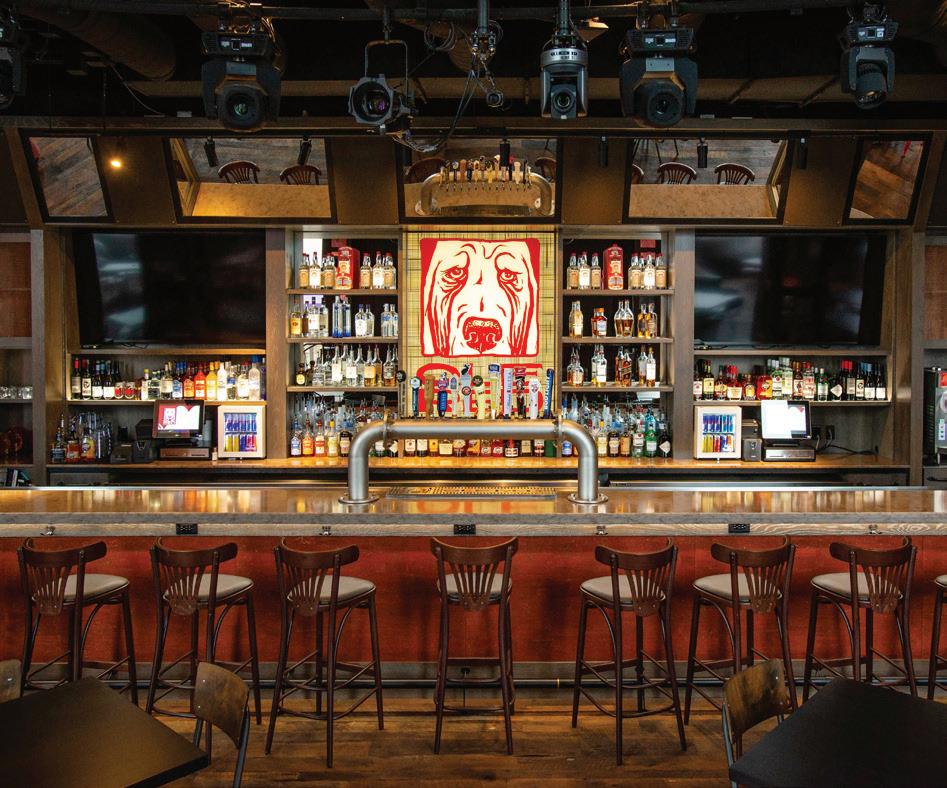
the rocker’s style.
“He’s also very loyal to Nashville as a city and has recorded and produced a lot of his music down there,” she said. “So it wasn’t like bringing a completely different outsider to the Nashville market.”
The Joseph family moved to Nashville in 2019, but Josh says they have visited regularly since the early 2000s.
“Coming from a larger city like Chicago and having done real estate around the country for the greater part of my professional career, there is no place that I have come across real estate-wise that is like Lower Broadway,” Josh Joseph says.
Marshall, who has previously worked for another local hospitality company and the Predators, says he doesn’t think that what’s being done on Broadway will happen anywhere else in Nashville or the country. He adds that other developing areas in Davidson County are creating their own unique cultures.
Josh says since Big Plan Holdings is also in real estate, if there’s an opportunity they see for a space, the hospitality concept depends on location and the consumer.
“Knowing who your audience is from a consumer base is extraordinarily important,” Josh Joseph says. “Your real estate, in my opinion, is the primary underlying driver of what you ultimately do with a site and a project.”
The company’s 12South area venue lent itself more naturally to its Playdate concept because of the area. Likewise, he says the company’s real
estate on Broadway led to the partnering up with celebrity brands.
“I’ve continued to see over the years Nashville do a really nice job of being very welcoming from a pro-business standpoint, looking to find ways to enhance and increase tourism,” Josh says.
In June, the Nashville Convention and Visitors Corp. released its fifth strategic plan for the hospitality industry co-led by Ryman’s Colin Reed and NCVC president and CEO Deana Ivey.
“Because Nashville is now communicating through these artists, through their social media platforms, to literally millions and millions of consumers, not just here in the United States, but all over the world,” Reed says, “that is generating tremendous demand.”
The NCVC told the Post that specific economic impact figures for Lower Broadway aren’t available, but Nashville saw a record 16.8 million visitors in 2023, and visitor spending also saw a record $10.56 billion.
“Celebrity bars are a unique marketing differentiator for Nashville,” Ivey tells the Post in a statement. “These artist-centered establishments serve as the physical epicenter of their brands, attracting thousands of their fans to our city. When fans travel to visit these bars, they’re not just enjoying the venue – they’re staying in Nashville hotels, dining in local restaurants and fully experiencing Music City.”
The Post previously reported that the strategic plan shows Nashville’s hospitality industry generates more than $1 billion in local and state tax revenue annually and more than 76,000 jobs.
“The well of talent that is in Nashville and the surrounding areas is not copied anywhere. So without that, this could not be created anywhere else,” Marshall says. “Musicians, and from the people that open a drink to clean the bars, they’re very important. That’s our backbone. And frankly, that’s why we’re all here. But I think what we’ve all been able to put together is why Nashville has been shining for the last 20 years.”
He adds that it will be important for the city to make strides in housing affordability for its workforce.
“We need to keep pushing on that,” Marshall says. “We try to lean in where we can on opportunities to push that idea as well.”
Reed says Ryman will put forth some capital toward affordable housing and support the

local transit initiative.
“Because these things are all linked,” Reed says. “If you can’t move people around in this city … and if you don’t have accommodation for the workers that we need to recruit to actually service the customer that continues to grow [the industry suffers].”
“I do believe there is also a connection to why organizations like Oracle want to come and have their world headquarters here,” Reed says. “Because they want to be in cities that are fun and successful and thriving. I think we’ll continue to see the inbound migration of quality organizations that want to be part of this part of the world.”
He cites another reason for an increase in Nashville tourism: having a convention center and the Opryland hotel, which he calls the most successful convention resort outside of Las Vegas, as a draw for big groups.
“The fun cities of America are where groups want to go,” Reed says. “We’re in the midst of this massive explosion of people wanting to frequent this market because it is the home of music.”
BPH’s Sydni Joseph notes that cities like New York, Los Angeles and Miami all have robust hospitality and entertainment scenes, but they are along the coasts, so Nashville’s central location gives it an edge.
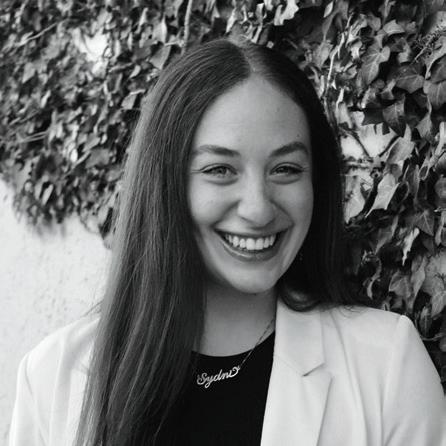
“I think from a geographic footprint of where Nashville actually sits amongst the vast majority of Americans, is also a strong proponent as to why it has taken off so much,” she says. “Nashville has opened the door over the past so many years to a much larger amount of the country to be able to access a city that has all of that.”
Reed worked as chief financial officer and co-president for casino company Harrah’s Entertainment before joining Ryman as CEO from 2001 to 2022.
“The thesis for gaming was that – gaming needs to be in Las Vegas, Atlantic City, maybe Reno, Lake Tahoe,” he says. “When all of a sudden gaming started to explode around the country, everybody got really concerned about, ‘Well, this is going to damage Las Vegas.’ But what happened was … as we built casinos all around the nation, we created customers that then wanted to frequent Las Vegas.”
He says that as more demand for gaming occurred throughout the country, more demand occurred for Las Vegas. That concept has shaped Ryman Hospitality’s mentality.
“Our strategy is to essentially create a farm system, all around the country, and hopefully, at some point, we may look at international,” Reed says. “And have a platform to put these young, emerging artists in other cities, but at the same time to be able to pick up and communicate with those consumers, and then cross-market them back to the city of Nashville.”
While Ryman is an established local company, and the Josephs’ BPH was born more recently in Nashville, other outside hospitality investors are in the celebrity partnership game.
Ohio-based TC Restaurant Group was one of the first to open a bar, restaurant, venue combination that carried a celebrity name in Nashville in 2017 with FGL House. That band is no lon-
ger together, so the venue has transformed into Lainey Wilson’s Bell Bottoms Up, which opened in May. While not locally based, TC Restaurant Group has established a strong local presence of brand partnerships with Luke Bryan, Miranda Lambert, Jason Aldean and Morgan Wallen.
Of course, before the arrival of all of the venues named after the artists themselves, artists were already in the game with concepts such as Jimmy Buffett’s Margaritaville. Alan Jackson opened up AJ’s Good Time Bar around the same time as Dierks Bentley’s Whiskey Row and John Rich’s Redneck Riviera in 2017.
As for whether continued investment in these kinds of partnerships is sustainable, Reed says it’s a simple question of supply and demand. The demand comes from the consumers who will continue to come here thanks to the push from the artists themselves, as well as the NCVC and hospitality companies who all will market Nashville as the place to be.
“The demand side, I believe, over the next five to 10 years, it’s just going to continue to grow and grow,” he says. “And then the question becomes, what is the supply side like? What are the things that are going to evolve here that are going to captivate the consumer when they come? So there may be more room for other bars and other music venues so when the consumer comes, they’re not standing shoulder to shoulder, but there is more product in this town for them to have fun.”
Reed cited the opening of Garth Brooks and Trisha Yearwood’s Friends in Low Places as an example of the kind of venue that makes Broadway a more authentic place. Reed says he doesn’t see other venues as a competitive threat but instead believes the variety only strengthens the city.
“The interesting thing for people like me and our company is trying to figure out what we have to do to make sure we do not kill the golden goose,” Reed says.
Nashville’s
hotel industry continues strong growth trend
BY WILLIAM WILLIAMS
ashville is a hotel city in many ways — and the announcement earlier this year that a St. Regis is planned for SoBro bolstered that theme.
The characteristic has become significantly noteworthy since the end of the Great Recession, as some hotels in the city now command $400 per night and more.
During the past 13 years or so, Nashville has landed multiple high-end hotel brands — including, but not limited to, Conrad, Four Seasons, Grand Hyatt, JW Marriott, The Joseph, Omni, Thompson, Virgin, Westin and W.
Obviously, there remain various brands not currently found in Music City and that in theory could be successful, according to industry officials. These include Le Meridien and RitzCarlton. Others — including Mandarin Oriental, Park Hyatt, Rosewood and Waldorf Astoria — may not be suitable for Nashville. Yet.
Jan Freitag, national director for hospitality market analytics at CoStar (and formerly with Hendersonville’s Smith Travel Research, which CoStar acquired in late 2019), said the city’s potential for luring an elevated level of hotel brands is very solid.
“The smaller Asian ‘jewel box’-type hotels with high-end amenities and corresponding high ADRs [average daily rate is used in the hospitality industry as a performance indicator to measure the average revenue earned per occupied room during a particular time span] are probably being discussed with owners of parcels
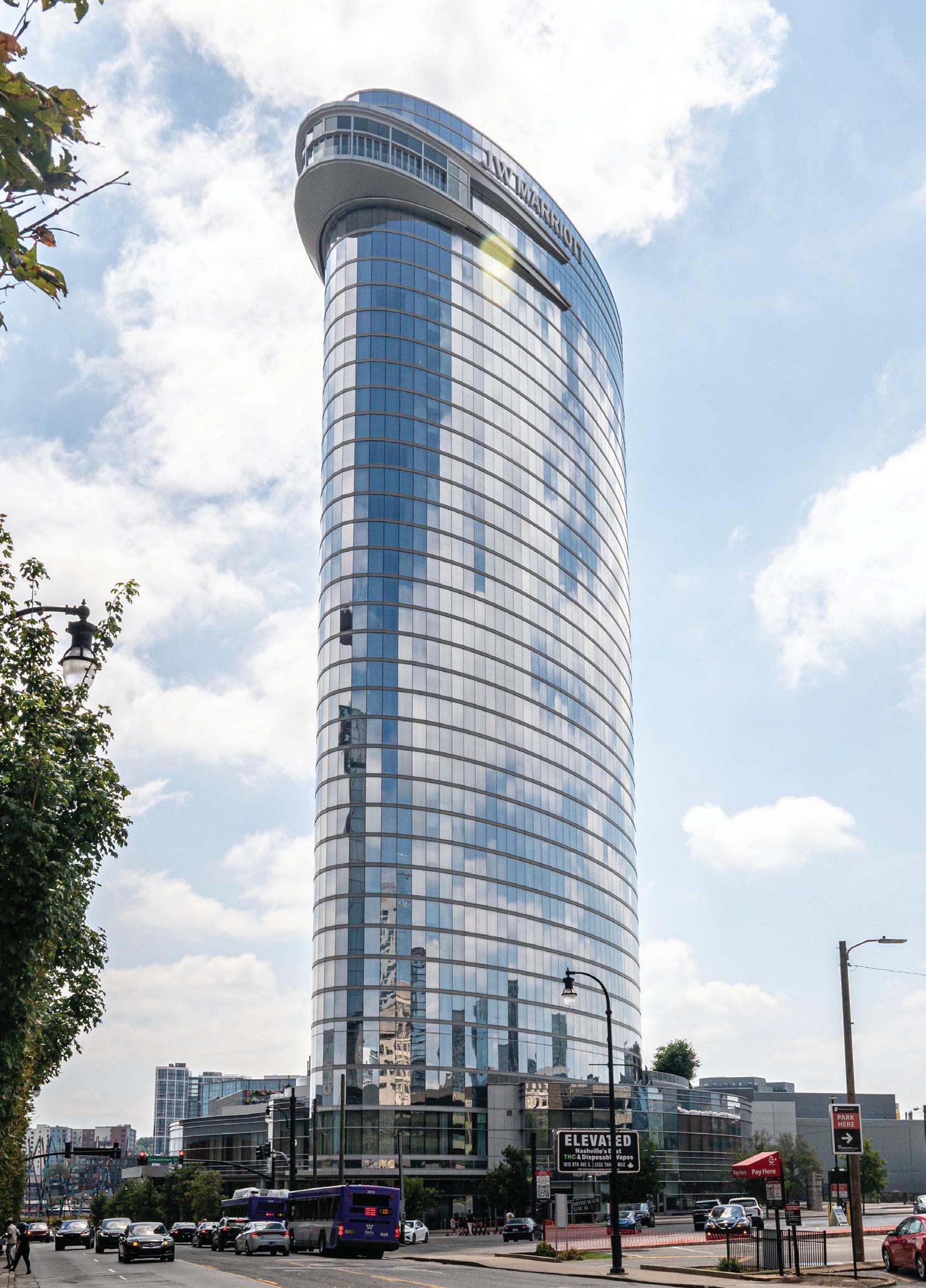
in the downtown core,” Freitag says.
“The question is if the customer pool is deep enough now to command high room rates on a consistent basis. So not just when Taylor Swift is in town but on a random Monday or Thursday evening in March. But with a dynamic city such as Nashville, neighborhoods get born and reborn, the East Bank will be a major draw for hotel guests, and I look forward to seeing new hotels and new concepts coming to fruition. Just because we cannot see a brand today, that does not mean we will never see it. Just wait.”
Freitag says Nashville’s collection of hotels continues to adapt to ever-changing consumer tastes, allowing the city to welcome leisure, corporate, group, family and event (such as bachelorette parties) visitors.
For example, and according to Nashville
Convention & Visitors Corp. statistics, Davidson County offers 39,972 hotel rooms, while the 14-county Nashville metropolitan statistical area includes 58,138 rooms. Hotel buildings with a collective 2,000 rooms are under construction, and approximately 14,000 rooms are planned.
Interestingly, Davidson County hotels in July saw occupancy rates, ADR (average daily rates) and RevPAR (revenue per available room, calculated by multiplying a hotel’s ADR by its occupancy rate) figures dip compared to July 2023 numbers, according to CoStar.
But despite the drops, Freitag says Nashville’s hotel industry remains strong. And as Nashville International Airport lands more international flights, Freitag says he might expect to see area hotels offer amenities tailored
to visitors and their countries of origin, thus making those spending time in the city feel more welcome than otherwise.
“Water kettles for British or Asian guests or bus maps and locations of bicycle rental stations for German or French guests are easy to offer and make a lasting impression,” he notes. “It’s tricky to be overly focused on one specific target market since it might be off-putting to others. The operator has to be very mindful that either this target market is large enough or the operator simply tries to be open for all — which is what the [typical] hotel does.”
As to concerns currently seen in the local hotel sector and that could prevent the city from achieving its maximum hotel potential in the future, Freitag is forthcoming.
“When I talk to hotel developers who look at Nashville, I always lead with, ‘I have no doubt that you can plan the room, finance the room and then build the room. But who is going to clean the room?’” he says.
“A well-trained labor force that has access to the jobs from where they live will continue to be the most important factor in determining Nashville’s growth trajectory. This is also a conversation about workforce housing and public transport, and I am encouraged to see that Mayor Freddie O’Connell has both of these items on the top of his agenda.”
And, of course, Nashville will struggle to achieve a robust and comprehensive level of hotel offerings without more international visitors — with those numbers to be maximized fully with more international flights to and from Nashville International Airport.
Though Nashville likely will never land an H World International hotel — the Frankfurt-based brand that operates primarily in the world’s largest and most cosmopolitan cities — Music City could, in theory, lure Pendry, a hotel company with a mere seven
U.S. locations: San Diego, Baltimore, West Hollywood, Chicago, New York City, Park City (Utah), and Washington, D.C. And if the Pendrys of the hotel world establish a presence in Nashville, could the city see, for example, a Sofitel (owned by Paris-based Accor) follow? In other words, could the highest-end U.S. concepts showing confidence in Nashville spur some luxury international brands to follow suit?
The answer points to Nashville International Airport (BNA), officials with which are hoping eventually to offer nonstop flights to some Asian and European cities, though many acknowledge the task is challenging.
“A concern could be that it takes much longer than expected to get more international air lift,” Freitag says. “But it looks like the BNA leadership is well on their way to usher in more flights to other transcontinental markets.”
On a positive note, the airport offers the Hilton BNA Nashville and quick access to the nearby Sonesta (a Boston-area-based brand that is expanding rapidly), two major additions that have positively altered air travel for the city, according to sources.
Leesa LeClaire, president and CEO of the Greater Nashville Hotel Association, says the Nashville hotel scene is diverse, a quality characteristic for a market that is looking to grow its hospitality sector.
“We have everything from historic hotels, limited service and full service, luxury hotels and boutique properties,” LeClaire notes. “Each caters to a variety of wants, needs, expectations and price points. Some hotels focus on large groups or small groups, individuals traveling with pets or a need for specific fitness or dietary expectations. Gaylord Opryland offers the SoundWaves waterpark as an attraction, along with meeting and convention space, music and shopping to appeal to a larger audience.”
More than anything, however, LeClaire says location can drive a specific brand to a specific location, with examples including Midtown’s Graduate Hotel near the Vanderbilt University campus or, more generally, extended-stay hotels positioned near medical facilities.
Deana Ivey, president and CEO of the Nashville Convention & Visitors Corp., says there is demand via the market’s convention business for international visitors and high-end leisure visitors, “who tend to be the most resilient during economic downturns.”
Ivey says the city needs a big box hotel (a facility that typically features 1,000 rooms or more) downtown. Though not downtown, Nashville already boasts one such facility with Ryman Hospitality Properties’ Gaylord Opryland Resort & Convention Center, the largest non-gaming hotel property in the United States with 2,888 rooms.
Luring a big box hotel is “a significant challenge, especially when bidding for mega conventions against other cities that offer properties with 1,000-plus rooms,” Ivey notes. “Convention groups prefer fewer, larger hotel blocks to keep their attendees together as much as possible.”
And though downtown Nashville is not likely to see the arrival of a hotel with 5,000 or more rooms — such as The Venetian Resort (more than 7,000 keys) or the MGM Grand (6,852 keys), both in Las Vegas — it eventually could accommodate a hotel with, say 1,500 rooms, sources say. For example, Marriott Marquis, a large-format hotel found in eight U.S. cities (including Atlanta and Chicago), could fit the bill.
“We are fortunate that the Nashville hotel scene has adapted to the ever-changing consumer tastes,” CoStar’s Freitag says. “Price points vary and amenities vary, but hotels are eager to welcome customers and give them a home away from home.”
Healthy leasing market fuels commercial development beyond downtown fringes
BY NICOLLE S. PRAINO
Following the region’s exponential growth, businesses are taking up space in Nashville and the surrounding area’s office supply.
The population of the 10 counties that make up the Nashville economic market grew from nearly 1.9 million in 2016 to almost 2.2 million in 2021. That’s an increase of more than 14 percent. More than 35,000 people have moved to the market since then.
“All of our regional partners would agree that the core has to be strong for the region to thrive,” Nashville Area Chamber of Commerce Chief Economic Development officer Jeff Hite says.
He says he believes 38 buildings downtown are more than 300 feet high, and 26 of them have been constructed in the past 10 years.
“Almost 70 percent of the Nashville skyline has been built in the last 10 years — I mean, that’s just a phenomenal run,” Hite says.
There have been 52 cranes up in Davidson County through August this year, and last year’s peak was 83 cranes.
“Office real estate will not get in the way of getting a deal done,” Hite says. “We have whatever product you want, whatever timeline you want, we can deliver.”
The chamber announced 42 business relocations and 32 expansions between 2021 to 2023 in the region. Eight of those relocations and eight expansions were in Davidson County specifically.
Cushman and Wakefield vice chair Charlie Gibson says companies will be looking at
the whole region of growth, and he used the example of industrial tenants in one area potentially bringing more provider tenants to another.
“If you think about where these companies not only want to set up shop, but where they want to park their capital and their human capital, over the next 20 years, they’re trending to blue cities in red states,” Gibson says. “Nashville is a market that has proven, not only can we roll out the red carpet for you and your existing employee base, but it is a market that is going to retract to attract new talent.”
Hite says when companies look at Nashville’s competing markets like Denver, Austin or Charlotte, many communities will make the same argument of cost of living, quality of life and even economic incentives.
“The community that can make the workforce pitch is probably going to win that project,” Hite says. “So talent development is critical right now in economic development, because job creators are chasing talent.”
Colliers Nashville CEO and market leader Janet Miller says of her time in the chamber: “Twenty years ago, you couldn’t get a headquarters to look at this city. We were doing lots of customer care centers and back office.”
She cites former Gov. Phil Bredesen’s leadership and push for “the civic furniture” to attract company headquarters, such as his bringing in the Titans as mayor in the ’90s.
“What these companies see is a qualityof-life improvement for the employees that make the move,” Miller says. They see their employees’ benefits such as no personal income tax and other cost-of-living savings.
While more recent moves such as Oracle and Amazon gain attention today, Miller calls companies like AllianceBernstein and Bridgestone the trailblazers.
Hite says, “Whenever you have one of those global brands that is really high on your community and really talks Nashville up,
that’s a huge positive.”
Miller and Gibson say industries that have remained strong in the Nashville area are health care and manufacturing, but what’s new is the technology companies.
“Every city longed for pure tech. That’s the nirvana that every city has been chasing, and Nashville has cracked into it,” Miller says. “I think that’s where we’re probably going to see the most growth because that’s where the most job growth is in the world.”
Gibson agrees: “We haven’t fully recognized the Amazon effect. We haven’t fully recognized the Oracle effect. I think that there will be more and more tenants that are popping up through tech.”
He adds that the music and entertainment industries are finding success alongside financial services, law firms and the education and automotive sectors. “What that creates is a very diverse local economy that in downturns is not going to be as elastic as other markets, where you might see swings from 10 percent vacancy to 28 percent vacancy,” Gibson says.
He explains Nashville might see rates hit up to 20 percent while other markets see up to 30 percent “due to the pressure of just having specific industries that are the driving forces there, whereas we can point to multiple sectors of employment.”
Hite says the buzz from out-of-market

relocations keeps the conversation going but adds that most of the job growth for any community comes from existing companies adding jobs.
Pinnacle Financial Partners director of associate and client experience Summer Yeiser tells the Post the company’s move to Nashville Yards from Pinnacle Tower at Symphony Place is to bring employees back together in one place since they have outgrown their space.
“We believe that a strong piece of our culture comes from people being able to spend time together, people knowing each other,” Yeiser says.
While employees have been back in the office since the work-from-home movement, the excitement around new amenities in Nashville Yards is seen as a draw for both employees and clients.
Pinnacle plans to move into Nashville Yards during the first quarter of 2025. The company will keep its retail space in the tower at Symphony Place, but the other floors will be leased by Highwoods.
“When we first moved to Symphony place where we are today, that was back in 2010,” Yeiser says. “We were the only tower there south of Broadway. So that looked much different then than it does today.”
She says Pinnacle was trying to stay ahead of the development curve with that location,
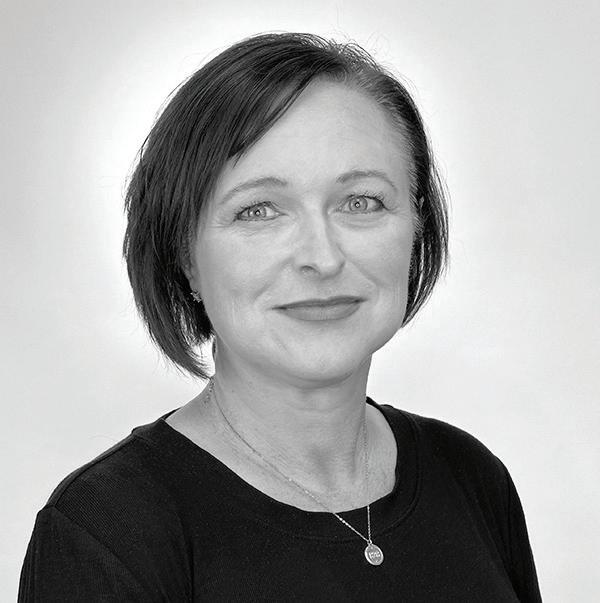
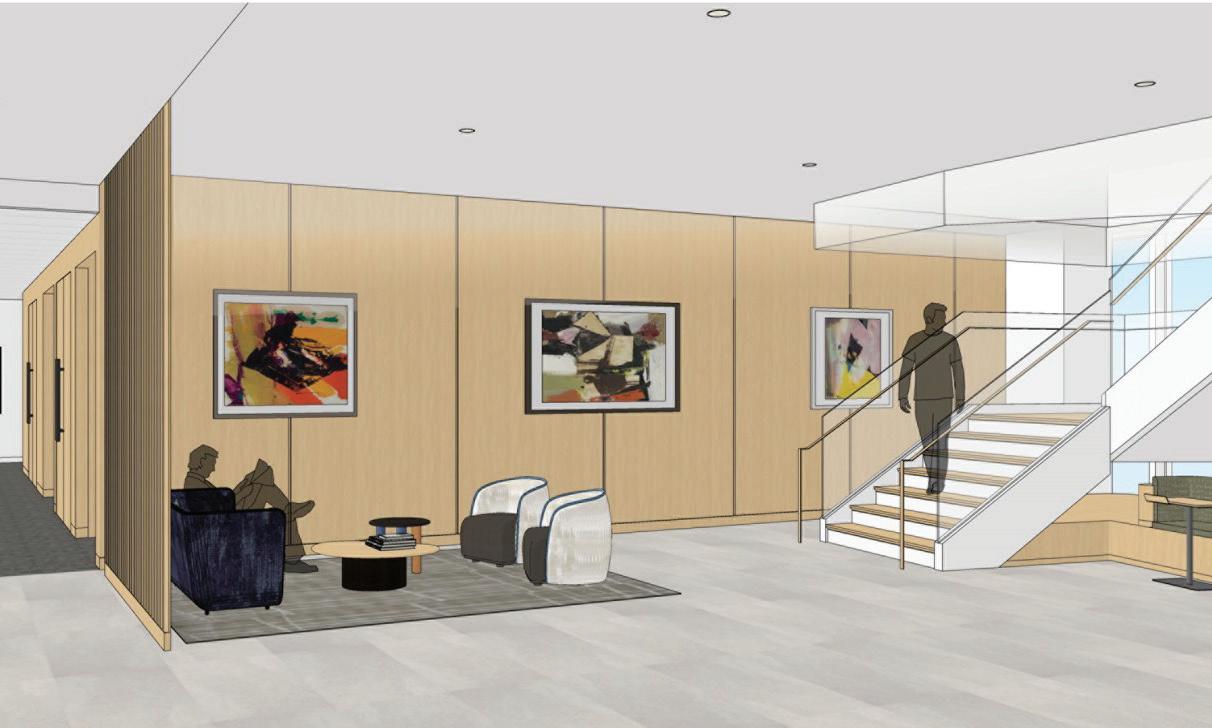
and now, seeing SoBro become a thriving area, they know they made the right choice.
“In a very similar fashion, as we’re now in a situation where we need more space, and we’re continuing to grow,” Yeiser says “It seems like Nashville Yards is a really great place for us because we feel like, again, it’s another opportunity to kind of skate where the puck is headed.”
Pinnacle will be the namesake of an event space in Nashville Yards. Yeiser says the goal was to be intentional about creating an experience for both clients and associates, and working together with AEG just made sense.
Southwest Value Partners and AEG’s development of Nashville Yards is just one example of the growing office landscape. With plans like Oracle coming online in the River North space spurring activation on the East Bank, Hite points out the unique aspect of large urban development.
“How many cities experiencing the growth that we have those type of opportunities? You know [up to] 100 acres available near the urban core — it’s just really rare,” Hite says. “These developers have this vision, and they take on the risk and spend their money.”
Gibson says Oracle’s desire to buy, own and develop its own land for a development to include its office is rare because of Nashville’s density.
“It’s very compressed in terms of the opportunities for any new companies to come in and actually own and develop their own real estate as an owner occupant, which is why tenants are going to go more the leasing route,” Gibson says.
Gibson cites the recent moves of Iron Galaxy from UBS Tower and Sirius XM from Bridgestone Arena to the AT&T Building.
“These are tenants that certainly had every
single option to go to new construction and get out of the existing [central business district], but they relocated from their current locations to another [central business district] product, [which] completely bucks the trend of every tenant that is leaving downtown,” Gibson says.
Miller adds the movement now is “flight to quality,” with new leases happening in Class A high-amenity spaces. Gibson and Miller both note that the changing office landscape of the downtown core is likely to see some pricing advantages, adding that new-to-Nashville corporate relocations could benefit from that.
“You absolutely have to keep up with the Joneses, if you will, of what the amenity packages are for the new construction,” Gibson says. “You have to say, ‘I’ve got everything that building has that’s coming out of the ground, but I can give you tenancy for 75, 80, 85 percent of the price of the new supply. If owners are not willing to spend the money and enhance their amenity package … then they are going to suffer with lease-up.”
He does believe there will be more demand back in the central business district if owners are able to attract those tenants and some sof the new construction supply gets absorbed, which could happen faster than it would in other markets.
“Once the shovel is in the ground, tenants are taking projects seriously, and you are reaching stabilization over a year-and-a-halfto two-year period,” Gibson says.
Hite adds, “All this growth we’ve had, this is absolutely wonderful, but there are challenges — transportation, infrastructure, gentrification, affordability. … But keeping Nashville authentic as we grow that is, to me, that’s a tough challenge.”
Green Hills, 12South continue to lure high-end boutiques
BY WILLIAM WILLIAMS
or years, and before Nashville’s postGreat Recession urban boom, Green Hills was the dominant player in Davidson County’s high-end retail community.
True, two commercial districts located near Belle Meade — one sandwiched by the Belle Meade Mansion and the Highway 70/100 split, and the other positioned within proximity to the White Bridge Road and Harding Place intersection — were a worthy competitor when collectively considered.
Green Hills, nonetheless, was viewed by longtime locals and recent newcomers alike as the most prominent area for high-end retail shopping. And that remains the case for many.
However, during the past five to six years or so, 12South has emerged as a destination spot for cosmopolitan types looking to pay top dollar for a handbag, a T-shirt or jewelry. That commercial stretch of 12th Avenue South — a mere roughly eight blocks — is now the city’s go-to destination for many folks (and particularly tourists) related to soft-good boutique retail shopping. Yes, The Gulch offers a vibrant dynamic for such commerce. But 12South, according to many with knowledge of Nashville’s retail scene, is now Green Hills’ main competition.
One might think this could be potentially concerning for Green Hills, with its merchants feeling perhaps somewhat threatened by 12South. Or equally concerning for the retail business owners of 12South, with Green Hills representing a foe that benefits from an insurmountable number of built-in advantages, including its long-standing history and
prestige, its relatively large land mass (with countless commercial buildings) and, of course, The Mall at Green Hills.
But those interviewed for this article feel Green Hills and 12South are effectively coexisting and flourishing.
Elam Freeman, founder and principal with Nashville-based commercial real estate firm Ojas Partners, specializes in retail real estate. She says Green Hills and 12South are both successful, in part, because of the dynamic that exists between the two. Each offers its own identity.
“Brands rarely feel comfortable doing business in both [Green Hills and 12South], given the geographic proximity to one another,” Freeman says. “12South has become so desirable because, unlike retail downtown, it attracts the locals. And unlike Green Hills, it also attracts the tourists. It is a great solution for brands looking to operate one store in the market.
“[Conversely], for brands that see themselves operating more than one store in Davidson County, [having a presence] in Green Hills for a purely local play and in downtown for a purely tourist play can make sense. Examples of these types of tenants include Apple, Free People and Sephora. More recently, we’ve seen some brands, such as Buck Mason and Gorjana, take space in both on 12South and downtown, which shows the strength of the market being taken to a new level.”
Freeman says there are few limits to the “high-endedness” — both in terms of the expensiveness of the inventory offered by the businesses and the sheer number of such retail businesses — for either Green Hills or 12South.
“Retail begets retail,” she notes. “Unless a brand is ultra-luxury with a very targeted consumer base and can pay its rent by making just a few sales a month, it needs a critical mass of other retail [nearby] to thrive.



Once that critical mass is established, it is ‘the more the merrier,’ because more brands in a neighborhood bring greater exposure to new customer bases through more aggregate marketing dollars being spent, which compounds for the betterment of all.”
Freeman says when a critical mass of retail is found in a walking district, a “shopping experience” is created, which is important to lure potential customers to enter stores — particularly key given e-commerce.
“12South is a textbook example of this,” she says. “Also, since 2020 there has been a migration of customers with higher disposable incomes who are moving to Nashville from major markets, where these luxury brands have a presence. This has been reflected in the brands’ e-commerce data. So there continues to be demand for luxury brands to plant a flag in the market. I suppose at some stage there would be a saturation point of ultra-luxury retail. But given the demand and price points we are seeing in the luxury condo and hotel space, it is apparent that the luxury and ultra-luxury shopper is found in Nashville. So I think we are far from reaching a saturation point in the luxury retail space.”
Freeman says Nashville is fortunate to offer a mix of locals and visitors who collectively can support the city’s high-end retail offerings. Norah Buikstra, general manager of The Mall at Green Hills (owned by Simon Property Group), agrees.
“Over 28 percent of our shoppers live more than 50 miles from the [mall],” Buikstra says. “We have a mix of both drive-in tourists coming from other areas in Tennessee and surrounding states, and tourists arriving via air. Being less than [approximately 15] miles from downtown and home to more than 55 uniqueto-market stores, including Tennessee’s only Nordstrom and only Restoration Hardware, we are seeing more and more tourists visiting just
to shop. Our tourist visitation will continue to grow as Nashville is quickly becoming known as a luxury tourist destination, and we can deliver on that luxury shopping experience.”
Despite increased rental rates, The Mall at Green Hills’ tenant occupancy rate remains healthy. As does the facility’s ability to lure tenants when others depart. Since 2023, the facility has landed high-end watch maker IWC Schaffhausen, New York-based fashion retailer Marc Jacobs, Italian fashion retailer Dolce & Gabbana, German fashion retailer Hugo Boss and Chanel Fragrance and Beauty.
“The Nashville retail rental growth has been strong, which is related to the strong retail sales and the demand to be in this market,” Buikstra says. “And Nashville’s downtown retail rent rate has increased by almost 80 percent since 2013, according to CoStar data.”
Of course, high-profile boutique retail in Green Hills is not limited to the mall. Hill Center Green Hills, Grace’s Plaza, The Glendale, Village Green and Greenbriar Village also offer some noteworthy businesses selling soft goods to discriminating customers.
“Green Hills will continue to densify,” Freeman says. “And with the surrounding demographics and Simon Property Group’s strength of relationships with national retail-

ers, luxury retailers looking for the obvious play to meet their tried-and-true customers will continue to flock to Green Hills.
Indeed, the future remains sunny for both Green Hills and 12South.
An example of the energy recently created and expected to spur such additional momentum can be found with 12 South Collection, a two-story building offering restaurant and retail spaces that opened about a year ago and is located at 2803 12th Ave. S. Nashville-based Laulima Development (David Bouquillon) and Dallas-based companies Ignite Realty Partners (Mark Masinter) and Mockingbird Interests (Stephen Summers) developed the site with the building.
When asked where 12South will be in terms of retail shops in, say, five to 10 years, Bouquillon says the scale and intimacy of the street, its murals and its proximity to surrounding residential streets will ensure the commercial strip remains a destination district.
“The street will continue to attract upscale, trendy boutiques and national, international and individual designers, retailers, shops and luxury goods stores,” he says. “I believe the street will continue to transform from day-tonight and new culinary options being a part of the 12South fabric. While the street will continue to transmute, new developments continue to embrace the mural artistry that I feel is a Nashville fingerprint.”
Laulima Development is not the only development company putting its stamp on 12South. For example, New York-based real estate investment and development firm Turnbridge Equities is seeing construction near completion on its Ashwood 12 South. The company’s building at 2311 12th Ave. S. recently opened. In addition, Nashville-based Hill Realty Co. developed the 12South site of 12South Flats.
The district is recognized for, among
others, boutique retailers Buck Mason, Bullets and Pearls, Draper James, Emerson Grace, Faherty, Judith Bright Jewelry, Madewell, Marine Layer and Molly Green.
12 South Collection alone offers a high concentration of luxe retail brands: Alice + Olivia, Jenni Kayne, La Vie, Leli Sadoughi, Mejuri, Paige and Rag & Bone.
“At 12 South Collection, our brand partners are in the luxury retail segment in the industry that specializes in selling high-end goods that are characterized by high quality and a high degree of exclusivity,” Bouquillon
says. “These industry luxe brands didn’t exist on 12th Avenue South until our 12 South Collection opened last fall.”
And with the momentum, of course, comes increasing rents.
Freeman says rents in Green Hills have increased relatively steadily (no more than 10 percent per year) during the past five years, adding that the rents can widely vary depending on age/condition of a building, the landlord, the positioning/visibility to the street, etc.
In contrast, for 12South retail businesses operating in buildings with 12th Avenue

South frontage (which is about 90 percent of the commercial tenants located within the district), rents have doubled and, in some cases, tripled, during the past five years, she says.
Rent increases or not, both Green Hills and 12South are expected to remain vibrant retail destinations, those interviewed for this article note.
“Retail is a business,” Freeman says. “But more so than most, it is interlaced with the intangibles of psychology, sociology, emotional connection, design and art. Businesses that get this — from local to international brands — are the ones that stand the test of time.”







Nashville Office Leadership


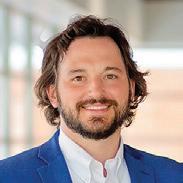
Kelly Cathey AIA Co-Managing Director
Christopher Goggin IIDA, Assoc. AIA, LEED AP Co-Managing Director
Brian Hubbard AIA Design Director


After 15 years in business, Imogene and Willie is all grown up while staying true to its roots
BY LENA ANTHONY
n 2009, Matt and Carrie Eddmenson stumbled upon a rundown 1950s gas station on 12th Avenue South and thought it would make the perfect location for their fledgling blue jean business. But the property was for sale, not for rent, and they were in no position to buy. Lucky for them, the 89-year-old property owner was willing to work with them.
“Carrie wrote her a letter sharing our vi-
sion of making and selling blue jeans in there,” Matt says of the gas station turned flagship store for Imogene and Willie. “Her openness to our idea is one reason we’re still here today. It’s a recognizable landmark that has walked hand in hand with the growth of the brand.”
Fifteen years later, Imogene and Willie has evolved into a grown-up version of itself, keeping all the cool vibes and commitments
to sustainability they started with while becoming a major influencer in the country’s small-batch fashion industry, which emphasizes craftsmanship, attention to detail, care and quality.
Upon signing the lease, the couple moved in (literally, they lived upstairs while renovations were underway) and got to work. The original Imogene and Willie was three businesses in one: a retail shop where one could procure the best-fitting jeans in town, a tailor shop where they built patterns and sample garments for big-name clients like Ralph Lauren, and, finally, a brand in its infancy, which included two pairs of jeans — Imogene for women and Willie for men — plus a handful of other handmade-in-the-USA garments. Success was immediate, which allowed them to stop making other people’s clothes and focus on filling demand for their own.
Many of the original pieces are still part of the Imogene and Willie collection, but behind the scenes, business operations look drastically different today, thanks in large part to KP and Katy McNeill, who became the Eddmensons’ business partners in 2018 after leaving Billy Reid, the Alabama-based menswear brand they founded in 2004.
“We thought Imogene and Willie was as unique as anything in the market,” KP says. “And having met Matt and Carrie and worked with them at Carrie’s family’s denim business, we felt like we could form a great partnership. We were looking for our next chapter and saw this is as a great opportunity to support an incredible brand with a loyal customer base.”
Today, Imogene and Willie has two retail stores (the other is in Austin, Texas), a sewing facility in Los Angeles, plus a warehouse and offices in South Nashville, which collectively house the company’s 80-plus employees. They
are on pace to hit an annual revenue of nearly $30 million this year, which is a massive 1400 percent increase from when the McNeills joined in 2018.
This type of growth may seem fast and furious, but KP says they’ve just unlocked the brand’s potential that was there all along.
“Everything we do is self-funded,” he says. “We don’t have private equity or growth capital behind us, which means we have the flexibility and freedom to build the brand the right way.”
That means being nimble and open to new ideas, like creating a line of socks and bringing production in house for their wildly successful graphic T-shirt business. In 2016, denim represented about 80 percent of the business; today, it’s down to a third.
Adopting a digital first strategy and investing heavily in web development also paid off: Now 70-75 percent of Imogene and Willie sales come from online.
They recently added a CFO to their team, and next on the horizon is another store opening. Katy says they are eyeing Brooklyn or Los Angeles — their two largest e-commerce markets.
Amid all this growth, they’re also taking the opportunity to celebrate this year’s milestone through 15 limited-edition collaborations from 15 like-minded brands. The products, from hats to watches to surfboards, each feature the tagline, “one of 15 limited edition anniversary collaborations, each between two brands who share a rare and meaningful bond: the ongoing, stubborn commitment to manufacture goods in the USA.”
The founders of Imogene and Willie came by that commitment honestly, having worked at Carrie’s family’s Henderson, Kentuckybased denim wash house that serviced brands like Levi’s and Ralph Lauren. In 2008, the company closed after the denim-washing
market shifted overseas.
Making Imogene and Willie profitable was an early goal for the McNeills, but straying from the company’s American-made commitment was never on the cutting table.
“It’s always been important to the company and the brand, and it’s also important to us,” Katy says. “And it’s never a difficult decision, because the people we work with every day hold us accountable to this. It’s something they’re passionate about, and it’s also their livelihoods. When we see our sewing team in Los Angeles who is like a family, and we meet all these independent contractors and vendors who work on our products, we love that we all can share in the same success.”
While KP says Nashville’s growth trajectory has been a net positive for Imogene and Willie, from foot traffic in their 12South showroom to a richer talent pipeline, he also worries about the shadow side of the city’s growth.
“This is not a new argument, but I think Nashville is seeing how a city’s growth can undermine the underlying creative and artistic forces that make a place unique,” KP says. “There are gems all around town, and we consider ourselves one of them, but with massive growth and the money comes with that, it’s too easy for those gems to disappear until all that’s left are national brands because they’re the ones who can afford to operate. It’s so important that we cultivate and support our underlying gems.”
The Eddmensons’ initial vision for Imogene and Wille was as a destination their customers would happily travel to, not something they’d stumble upon.
“Our customers weren’t casual shoppers, and so we weren’t looking to be in a major shopping area,” Matt says. “Fifteen years later, and we’re on the most shoppable street in Nashville.”


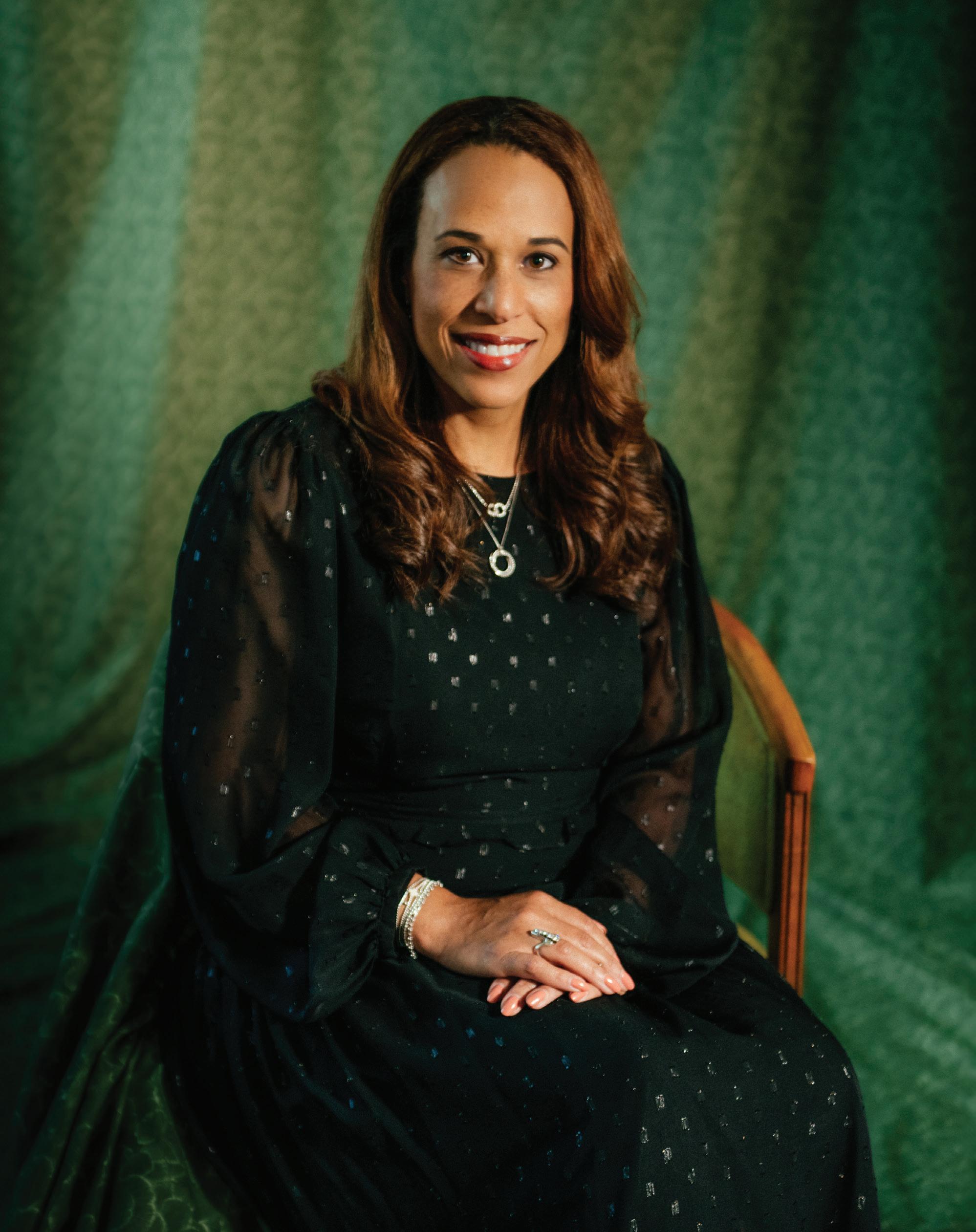
CEO & PRESIDENT, Girl Scouts of Middle Tennessee
Danielle Barnes is the type of woman with a ve-year plan — or perhaps more of a 25-year plan.
From age 6, she knew she wanted to be a doctor or a lawyer. e selfdescribed “type A” personality became the latter.
“I’m just one of those people that had my whole life planned up until the age of 30,” Barnes says with a laugh. “I tell people it was even down to ‘insert husband here.’ ankfully, he agreed.”
She earned degrees from Atlanta’s Spelman College and the University of Tennessee College of Law. After several years as a practicing lawyer, instead of moving toward becoming a partner, she opted to make the leap to state government. She served as a Department of Human Services commissioner under two di erent governors. Barnes had thought she would stay at the job for a few months while she gured out her next move, but ultimately, she stayed for 16 years.
e Department of Human Services changed her trajectory, she says, and she couldn’t shake the need to identify with the purpose of the place she works for. After she left state government, Barnes liked working at EY and succeeeded as executive director of the IT company’s health and human services pillar, but the feeling returned.
“ at need to connect the mission and the purpose and the passion to what I did every day was starting to get farther and farther away,” she says. “I’m helping someone to help someone to help someone else. I just kept getting so far removed
BY HANNAH HERNER
that I started to feel that void again.”
Girl Scouts of Middle Tennessee helped her get back to her new 25-year plan when she took over in December. She says the organization is at a critical point. It has a storied history and base of volunteers and backers, but the girls of today are di erent. It is more di cult to keep them engaged. e 10,000 girls and 6,000 volunteers that make up Girl Scouts of Middle Tennessee represent a membership decline in the region, which aligns with the organization at large.
Barnes still gets a lot of questions about Boy Scouts (soon to be known as Scouting America) expanding to include more gender identities. However, she doesn’t see that organization as a direct competitor.
Instead, she’s focused on involving girls who hadn’t participated in the program before. An example is Troop 6000, a program that focuses on unhoused girls. Using a shortened curriculum called LEAD, Girl Scouts aims to reach girls who live in public housing and rural communities, too.
Regarding motherhood (she has a teen daughter and a son), she says she’s been lucky to have supportive supervisors and family. However, she acknowledges it is not that straightforward. e mental load will still fall on the mother more than the father. For example, while her family may cook, she’s the one putting together the menu.
Barnes says she thinks a silver lining of COVID-19 pandemic is seeing a more human side of coworkers — seeing how what’s at home (kids, pets) impacts a per-
son’s day to day.
“ e balance is not real. I don’t leave my house and say, ‘Home is done, just work,’” she says.
As a leader, she looks for people who ask questions and propose solutions and who are willing to take measured risks. She’s a big proponent of raising one’s hand to try something new.
“I tell people I hire for attitude, not aptitude,” she says. “Most jobs are 99 percent of what you’re willing to do, willing to learn, willing to lean in on. Most of it, I can teach you.”
Barnes’ tenacity, the quality that made her so successful thus far, shows up on her face.
“ ere’s still very much the stigma of angry Black woman,” she says. “And when I think, my brow furrows. I have been told that my face looks very mean. I’m just thinking. For me, I’m very cautious of: What does my face look like? What does my body posture say? I don’t wear my hair curly to certain events.”
Over time, her need to temper her Blackness and femininity has faded, she says, in part due to her becoming older and more con dent. ankfully, gone are the days when her higher-ups suggested she wear a skirt to help close a deal, she added.
She recently appeared as the only woman in a cigar bar to discuss a transaction.
“I do think the tides have turned a lot,” she says. “I think as a gender, we have become more comfortable. We’ve become more comfortable in our space and in our high heels, if you will, to be able to make those kinds of moves.”
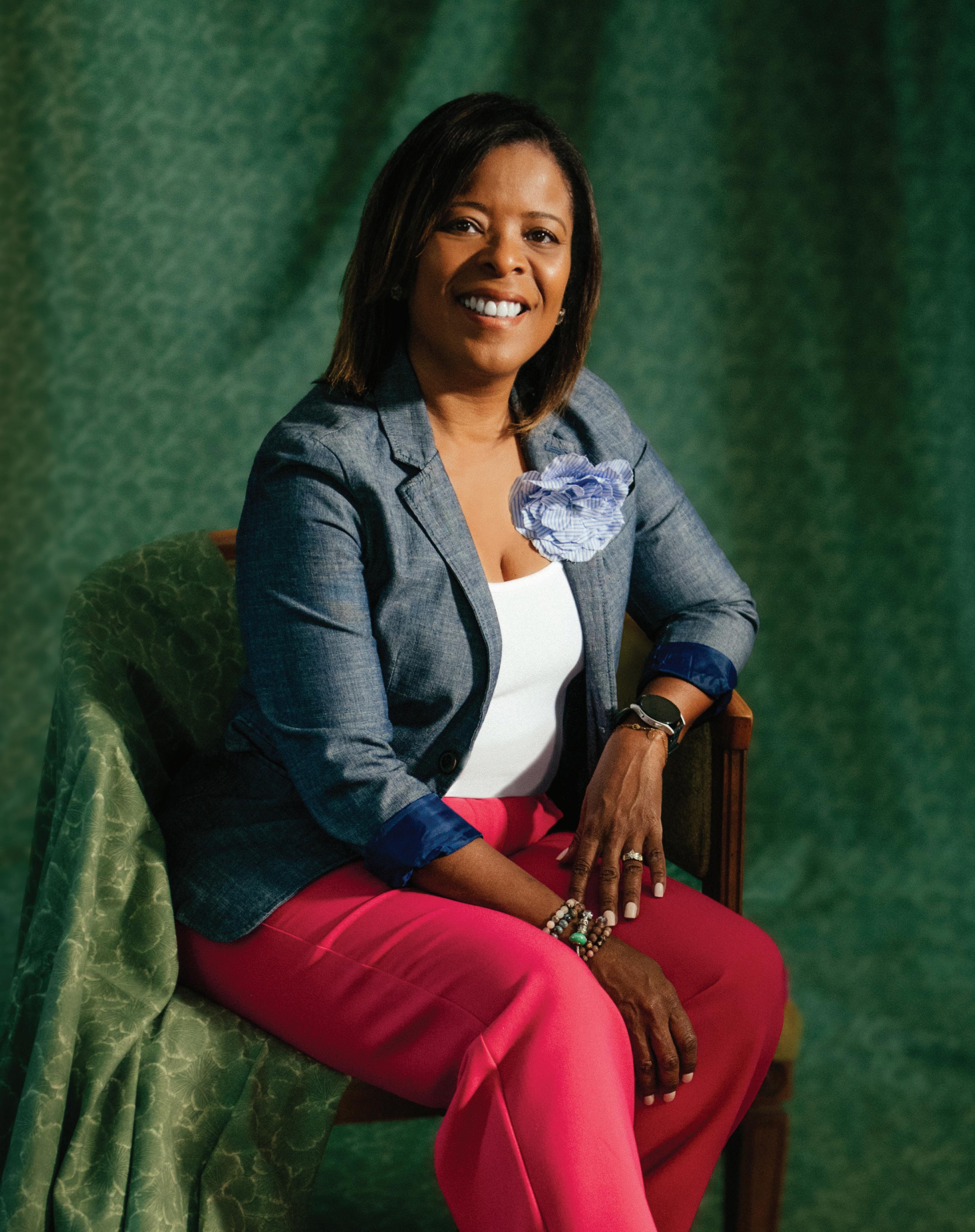
Katina Beard is a loyalist. Having been with Matthew Walker Comprehensive Health Center since 1996, she is a rare bird in a time of frequent job-hopping.
One thing that kept her on board was the organization’s mission. It has been in her heart since she learned about community health centers while studying at Tennessee State University. She graduated with an undergraduate degree in health care administration and planning and went to Meharry Medical College to earn an M.S. in public health.
“ e outpatient setting really called to me, and being able to serve communities that needed health care — communities of color, poor communities,” she tells the Post.
It’s righteous work that she feels called to by God, she says.
“Me being here for 27 years is really because I just believe in the work of this organization, but I also believe in the model of community health centers very strongly,” she says. “ at’s what keeps me here. It’s the people. It’s the mission. It’s the work. It’s the purpose.”
Another reason for her longevity was the opportunity to reinvent herself over and over again within the same organization. She was the center’s rst operations manager at the start of her career, managing a sta of around 30 people. en she became a liaison between sta and architects when the organization built a new building. Next she moved into grant writing and program development. In 2014, she became the CEO.
Matthew Walker’s clients are resilient in the face of adversity, so she strives to
BY HANNAH HERNER
embody that quality in her leadership and instill resilience among the organization’s sta .
“We lean into hard times,” Beard says. “When the tornado came, we leaned into it. When nances got hard, we leaned into it. We’re not a skittish organization.”
She’s also not afraid to delegate and give others a chance to represent the organization. She knows many of them care about the mission just as much as she does.
“I’m not the only one that goes out now and sits in meetings and represents the organization because I know I have other people that are capable of doing that,” she says. “ ey are able to navigate our partnerships and our relationships and maintain the integrity of our mission and our vision.”
Health care may be a male-dominated industry, but Matthew Walker has always been led by women, she says. ey outnumber the men on sta .
Beard found a mentor in former CEO Michelle B. Marrs. Noting that Beard needed more professional clothes than she could a ord, Marrs brought her a bag of clothes from her own closet.
“ at had to be 20 years ago,” Beard says. “I still wear some of those clothes, because she cared so much about me and my image.”
Being in a female-dominated and majority-Black workplace gives a sense of comfort, Beard says, but it’s been a journey to bring her full self to work. Only in recent years did she start braiding her hair for professional headshots. She thinks a lot of women struggle with
balancing a sense of self with professionalism in the workplace.
“We’re trained to always show up with a sti upper lip like it’s all OK,” she says. “It’s not OK some days. Stu is down on the ground, around your feet. I’m sitting at this table trying to not bust out crying. ... I’m trying to keep it all together because if not, you’re an irrational, emotional woman, like, ‘What’s wrong with her today?’”
Beard’s directness is something she likes about herself, something that became ingrained by her upbringing in Chicago. However, she has faced backhanded compliments as a Black woman who also appears younger than her years. One common example is, “You’re so articulate,” she says.
“Being an African American leader in certain communities and at certain tables, people still wonder, how did you get here?” she told the Post. “People are amazed that we can pull together our nouns and our verbs and not be emotional and get our point across and are not looking for any type of savior. And I say that to really well-meaning white people.”
When faced with a new challenge, Beard’s daughter will pull out a common Gen Z saying, “I’m just a girl.”
“I know a lot of women who, at the height of their career, still don’t show up as a girl in the room. We show up with our suit jacket on with a lapel ower, a sti back pulling up to the table, she says. “It’s never been a soft space.”
She’ll say to her daughter, “Well, I’m just a girl too!”
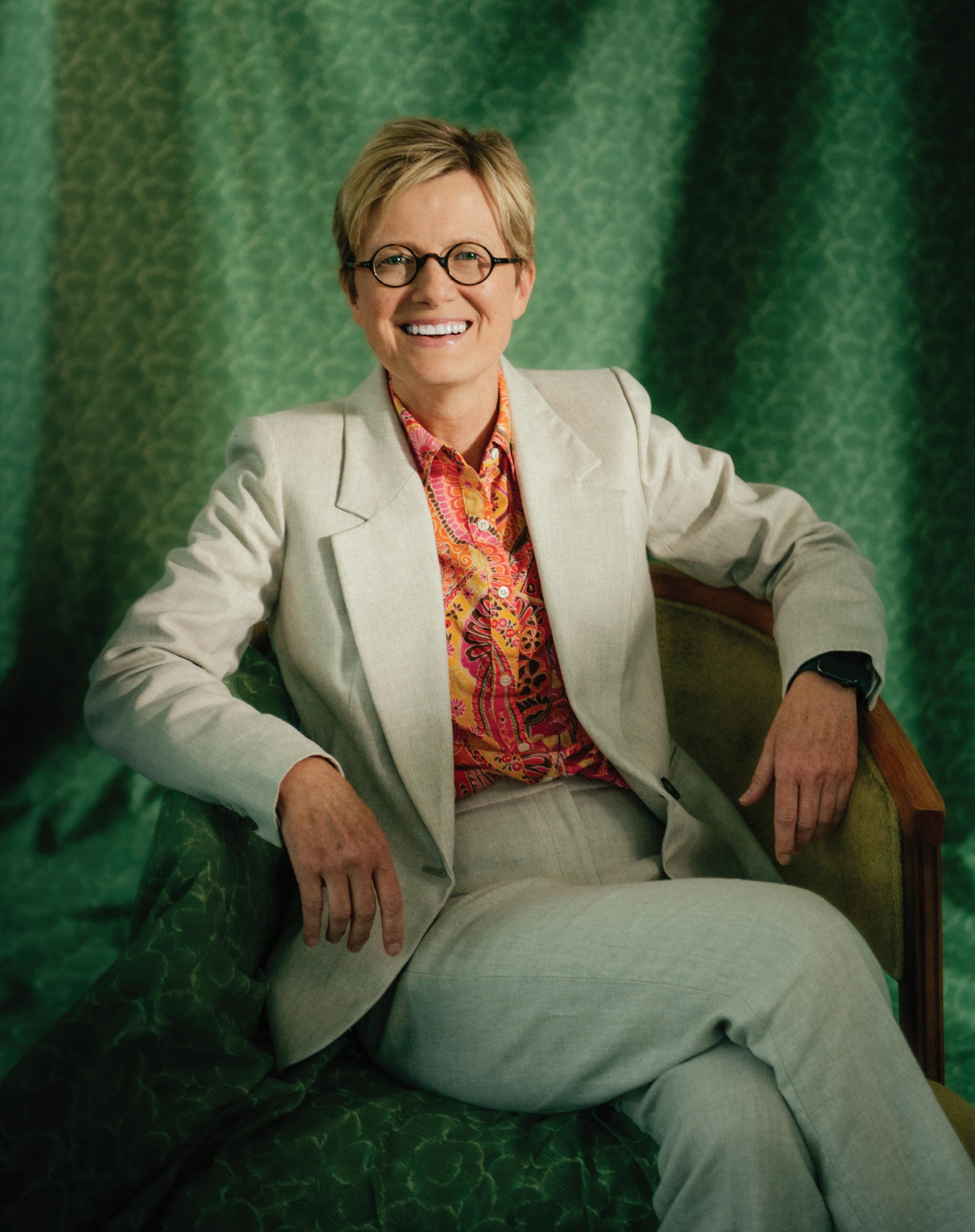
PRESIDENT, COO & ALT. GOVERNOR, Nashville Predators
Despite being one of the top female leaders in the National Hockey League, Michelle Kennedy says she still sees herself as a girl from a small town in Kentucky who played little league baseball right alongside the boys.
“No one ever made me believe I couldn’t do anything I wanted to do,” Kennedy says. “I was smart enough to discern that maybe I was doing some things that not everyone was doing, not every little girl was doing, but I think it created just a whole lot of con dence in me that I wouldn’t have had otherwise.”
Kennedy credits her upbringing and her parents for that attitude. Nowadays, she says, where she has worked and who she has worked for have usually aligned with her beliefs in leadership.
“You always need to choose an organization to work for and people to work around, who you feel like respect everyone,” Kennedy says. “I’ve just been around people who have been hugely respectful of me and appreciative of what I bring to the table, and again, and those are genderless opinions.”
She says the Nashville Predators today have ve men and ve women on the executive team. Kennedy says she hopes to try to debunk the idea of maledominated elds because there’s no reason women can’t be in those positions.
“I just don’t want anyone to think that they can’t do anything in this industry because of what they look like, what their experiences have been in other places relative to those same kinds of things,” she says. “It’s really important
BY NICOLLE S. PRAINO
for people to understand in this industry, if you’re working for the right organization, if you’re in a good place working with and for and around good people, great things are going to happen.”
She’s one of few women to ever hold the title of president of an NHL team, and the o ce jokes now that she started out as an intern in her 30s.
Kennedy began her career with the Preds in 2008 as the organization’s rst in-house counsel. But before she ocially joined, she says she and the team got a chance to try each other out while she nished law school. At the time, she was working for Vanderbilt University Athletics and consulting with the school’s CFO.
“By the time we had sort of done that yearlong audition with each other, it felt just regular and normal,” Kennedy says. “It came about in a very odd way, but I felt so fortunate to be able to stay in the city that had become my home.”
She has had several titles since joining the Preds, becoming chief nancial o cer and then chief operating o cer before adding president and alternate governor in 2023.
While she has increasing responsibilities today, it was during her rst years with the organization that she went through some of her greatest challenges. She hadn’t had experience in a law rm but often says she practiced “street law” while she was working at Vanderbilt before she got her law degree. Still, she was thrown into trial by re during the years the Preds were dealing with ownership changes and bankruptcy is-
sues after William “Boots” Del Biaggio was accused of nancial misconduct and convicted.
“Getting through a lot of that stu in my rst three or four years was probably the most di cult part of this,” Kennedy says. “Remembering those things, number one, makes me think I’m glad I was young and dumb, or I may have just stopped coming to work. ose were not fun times. But number two, as I look back on it now, I think about how ful lling it is that we have worked our way to a place of relative prominence and respect and all that in this community.”
She really loves Nashville, and the team makes giving back to the community a priority. She calls the city home now and says the sports teams from the Titans to Nashville Soccer Club to the Nashville Sounds all rally around each other.
“I come to work here every day, but what we have built here is much bigger than me,” Kennedy says. “It means that people are recognizing our organization as a signi cant organization in Nashville, not only for the purpose of entertaining and hockey ... but through our foundation and the connectivity with the community,”
When it comes to creating that kind of culture within the organization, the e ort must come from the top.
“ e gold nugget is really caring about people, and I do,” Kennedy says.
“If that then creates a sense of leadership or con dence, great, but at the essence, it comes from wanting others to feel a part of whatever’s going on.”

Candice McQueen learned about being a leader in education from her mother.
“She was a National Distinguished Principal, won an award from President Clinton at the time back in the ’90s for what an extraordinary school leader she was. She was a school principal at multiple schools. She led one of them to National Blue Ribbon status,” McQueen says of her mother, Brenda Hunter. “But what I really learned from her from a leadership perspective is she taught me how to be an authentic leader.”
McQueen has been president of Lipscomb University since 2021, but she has more than 20 years of experience in education. She’s served as a classroom teacher and higher education leader in roles with nonpro ts and for state government. Previously, she was CEO of the National Institute for Excellence in Teaching and was also former Gov. Bill Haslam’s commissioner of education.
“You need to be who you are as you lead” — McQueen says that is what she ultimately takes away from her mom. “Don’t try to be someone you’re not. Be who you are. Maximize your strengths, lead from those strengths, and model hard work.”
at family connection is even more important now in the work she does every day at the university. In addition to her own undergraduate years, her parents attended school at Lipscomb, and her daughter is currently in her undergraduate studies at the university.
“It’s an incredible opportunity par-
BY NICOLLE S. PRAINO
ticularly to be the president of the university where you attended as an undergraduate, so this is a place that I love for so many reasons,” McQueen says. “ e mission of the university is who I am. It’s amazing to be able to be a leader when you are intimately connected to that mission and it’s who you are. So every day is rewarding. Every day feels like you are really contributing to something that has greater meaning.”
She adds that working with the students and faculty members on a regular basis is its own reward because she enjoys having a people-oriented job. She wants young girls and women across the country to be able to point to a leadership role, such as the president of the university, and see a role model.
In education, McQueen points out there are few women in leadership roles such as the presidents of colleges or superintendents in K-12 education. For her at Lipscomb, she says it’s been important to have a team of female leaders that can support the growing student body and faculty who are mostly women.
“In education, while we are a eld that is primarily female, from teachers to faculty members and so on,” McQueen says, “you have fewer and fewer that actually move all the way to the presidency role or the superintendency role. So for me, I love seeing those role models that I can point to, and so it’s important to continue to move in those directions.”
She says it’s important to continue to have conversations about women in leadership and to be attentive to the fact
that some professions may still have a ceiling for women. at doesn’t mean it’s impossible to overcome.
“You may be the youngest or the least experienced or you may be demographically a di erent person than everyone else in the room,” McQueen says, “but if you come prepared and you’re engaged and you’re learning, you become equivalent to the other people in the room because preparation really can eliminate some of these other differentiators.”
What that means for individuals who are pursuing the next step in their career is that they should continue to reach for growth on their own too.
“I have always been a person who felt like if you are individually moving and growing, and you’re doing it with humility, but at the same time consistently trying to be the top in terms of your eld and your expertise – then opportunities will open up to you,” McQueen says.
She says she’s seen that in her own experience, and while she’s already been successful in so many areas of her career, she is not done reaching for improvements.
“I always think there’s opportunities and growth, and even within a job there’s so many new things that you can explore within the same place,” McQueen says. “I hope until I’m breathing my last breath that I’m continuing to grow and move forward into things that are meaningful and mission-driven opportunities.”


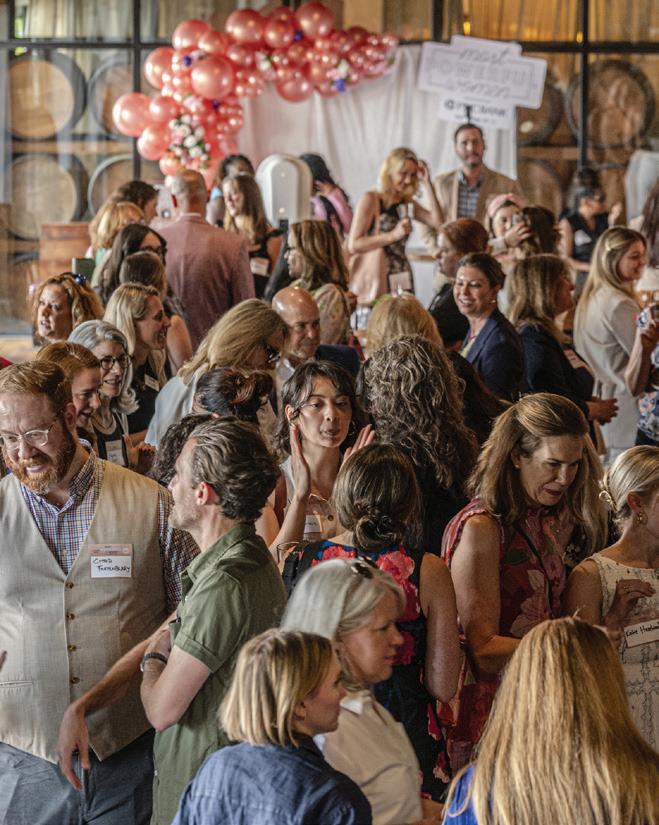


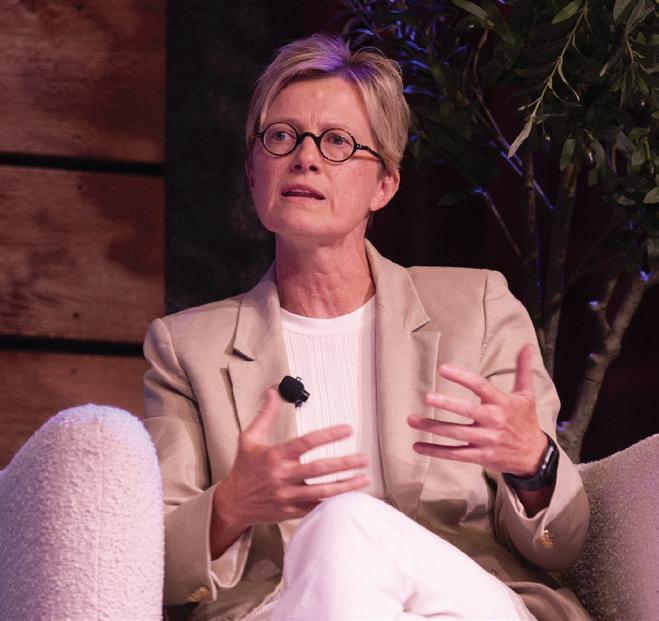
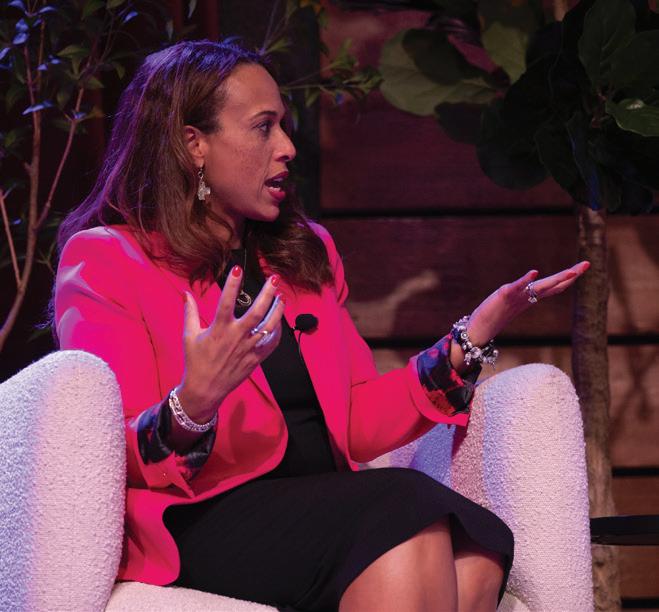
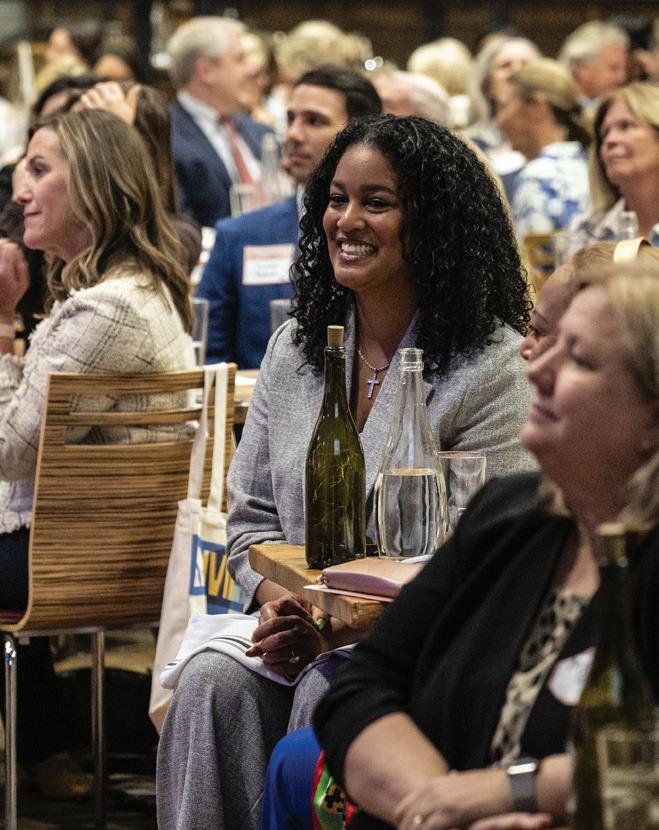




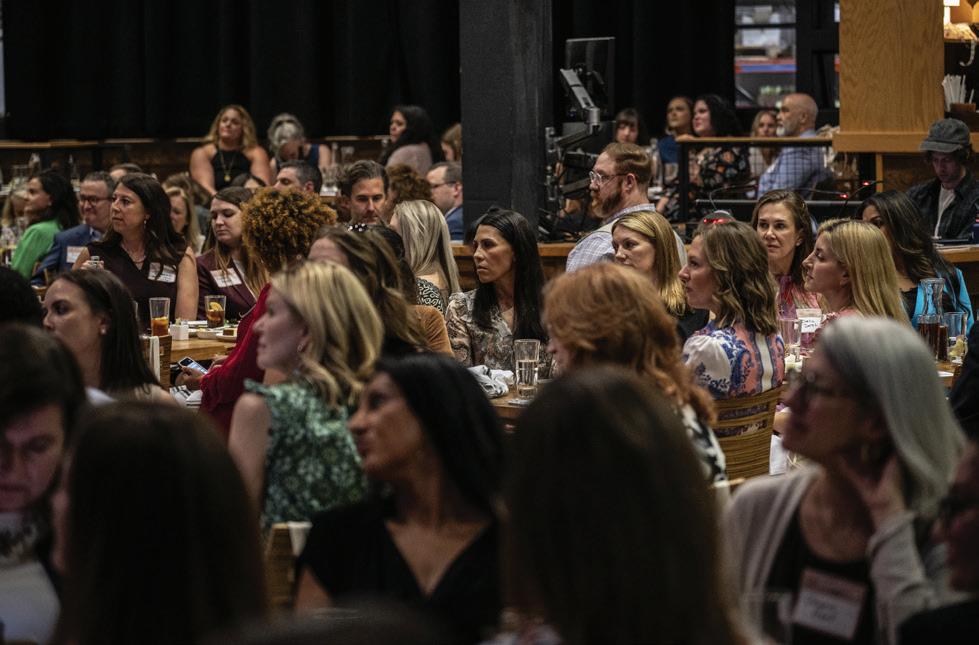
Since 2011, the Nashville Post has named local female leaders as the Most Powerful Women.
At our event in August, we unveiled the Post’s Most Powerful Women as Danielle Barnes, Katina Beard, Michelle Kennedy and Candice McQueen.
More than 300 of Nashville’s business leaders gathered at City Winery for a lunch and panel, presented by PNC Bank, featuring the four women and moderated by Colliers Nashville CEO Janet Miller who is a former honoree herself.
Barnes’ desire is to build communities and leaders of women, girls, and those who are disadvantaged. She became CEO and president of the Girl Scouts of Middle Tennessee in December 2023.
As the CEO of Matthew Walker Comprehensive Health Center, Beard serves more than 20,000 people per year who may not otherwise be able to a ord health care.
More than just selling hot dogs and hockey tickets, Kennedy’s aim as the president, COO and alternate governor
of the Predators is to build up the others in the o ce and keep a strong connection with the community.
Even before becoming the rst female president of the 130-year-old Lipscomb University, McQueen’s goal has been to help educators and students using innovation and preparation methods.
e women discussed mentorship, leadership styles, networking advice and nding balance. Keep reading to learn more about each of the women and their best personal and professional tips.
Post sister publication Nfocus is celebrating its 20th anniversary of identifying the philanthropists, volunteers and board members who help make sure the city’s nonprofits continue to thrive. Local organizations annually nominate their most dedicated supporters, and Nfocus chooses 10 to spotlight. To learn more about the 2024 nominees, pick up the September issue of Nfocus or visit nfocusmagazine.com.



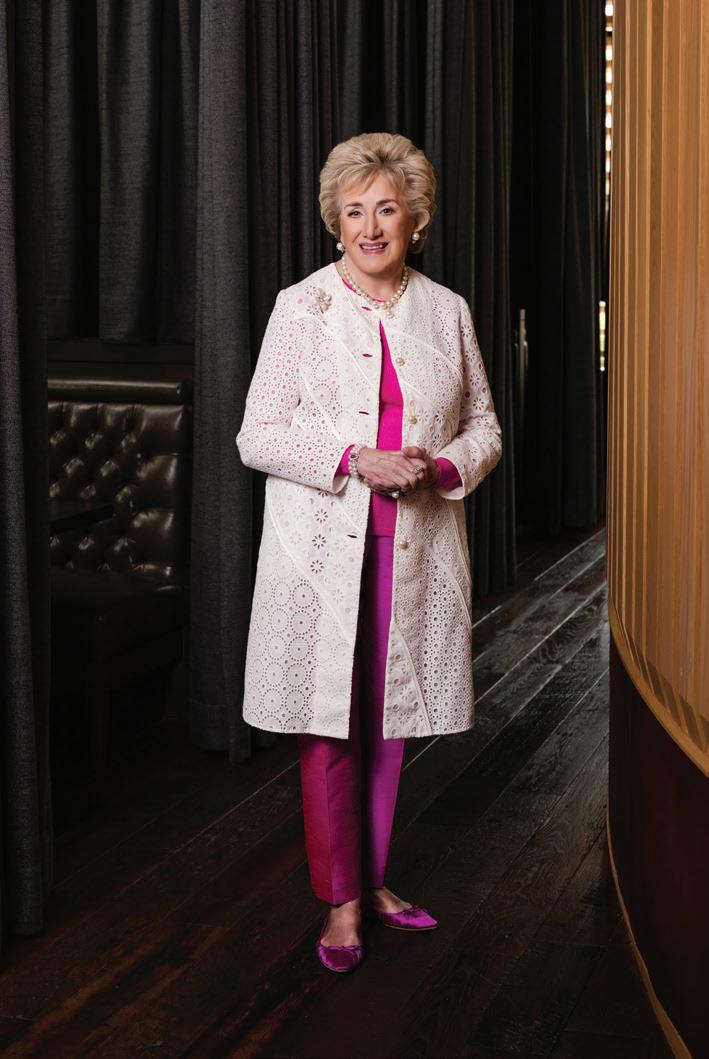






The women celebrated at this year’s event were preceded by 11 classes of exceptional honorees. Here’s who helped us share lessons on leadership, growth and inspiring others in years past.
2011
Sharon Hurt, Je erson Street United Merchants Partnership
Ellen Lehman, Community Foundation of Middle Tennessee
Jenneen Kaufman, Tennessee Titans
Linda Rebrovick, Consensus Point
Claire Tucker, CapStar Bank
2012
Megan Barry, Premier
Agenia Clark, Girl Scouts of Middle Tennessee
Aileen Katcher, Katcher Vaughn & Bailey
Dawn Rudolph, Saint Thomas Health
2013
Jacky Akbari, Nashville Career Advancement Center
Sherry Stewart Deutschmann, LetterLogic
Stacey Garrett, Bone McAllester Norton
Janet Miller, Nashville Area Chamber of Commerce
2014
Lisa Boggs, Bridgestone Americas
Glenda Glover, Tennessee State University
Heather Rowan, TriStar Centennial Medical Center
Sally Williams, Ryman Auditorium
2015
Paula Lovell, Lovell Communications
Joelle Phillips, AT&T
Renata Soto, Conexión Américas
Christie Wilson, The Wilson Group Real Estate Services
2016
Tammy Hawes, Virsys12
Beth Hoeg, Trinisys
Nicole Tremblett, HCA Healthcare
Rachel Werner, Built Technologies
Maneet Chauhan, Morph Hospitality
Jane MacLeod, Cheekwood
Mekesha Montgomery, Frost Brown Todd
Sharon Roberson, YWCA Nashville & Middle Tennessee
Carol Yochem, First Horizon Bank
Jane Allen, Nashville Entrepreneur Center
Mignon Francois, The Cupcake Collection
Shanna Jackson, Nashville State Community College
Becca Stevens, Thistle Farms
2021
Kate Burke, AllianceBernstein
Cordia Harrington, Crown Bakeries
Dee Patel, The Hermitage Hotel
Tina Tuggle, Tennessee Titans
Shubhada Jagasia, Ascension Saint Thomas Hospital
Zulfat Suara, Metro Council At-Large
Nancy Keil, Second Harvest Food Bank of Middle Tennessee
Sarah Trahern, Country Music Association
Adrienne Battle, Metro Nashville Public Schools
Deana Ivey, Nashville Convention & Visitors Corp.
Candice Lee, Vanderbilt University
Jennifer Turner, Tennessee Performing Arts Center







is working on the Boys & Girls Clubs of Middle Tennessee North Nashville renovation, workforce housing (read more about that concept on page 46) and mixedincome single-family homes.
How does land equity work?
Developer leverages land equity for growth that serves all income levels
BY HANNAH HERNER
Jennifer Horne wants to see equitable economic growth in Nashville. She is perhaps especially invested in this idea because she’s from here. The Music City native and Vanderbilt University graduate founded Urban Campus & Core real estate development and advisory firm in 2020. The firm has since grown, claiming $1.2 billion in debt and equity and more than 62 million square feet of project and nine employees.
Horne wasn’t new to the industry when she started on her own. She had 12 years under her belt as an executive at Lendlease property management company.
Horne’s firm focuses on land equity, and is currently working with Born Again church and The Clear Blue Company to build a ordable units for seniors on church land. In addition, the firm
Land equity investment is when you use the value of a piece of land that you own as a form of investment. It’s similar to the way people might use their home equity (the part of their home that they own outright) to secure a loan or make an investment. Using land equity allows you to leverage an asset you already own to access more capital. If the land increases in value, your equity also increases, potentially giving owners more investment power in the future.
How do you choose which projects to take on?
We look for values alignment in any project we review. We are drawn to projects that o er the opportunity to create positive impacts for the community and improve equitable outcomes for diverse stakeholders. We often partner with institutional landowners like nonprofits, churches and universities to activate underutilized real estate. We look for partners who want to invest in a sustainable future that o ers broader benefits than just traditional economic drivers.
How do you make your developments economically sound while serving people who have lower incomes?
Our approach to making developments economically sound while serving people with lower incomes is rooted in a blend of innovation, sustainability and community engagement. We believe in creating developments that not only generate positive economic returns but also foster equitable growth in underserved communities. To do this we focus on several key elements:
• Collaborative partnerships that allow us to reduce development costs and create projects that are financially viable while still addressing the needs of low-income residents
• Sustainable development that ensures long-term cost savings through energy e ciency and reduced environmental impact. This approach lowers operational costs, which, in turn, helps keep housing a ordable for residents.
• Socially responsible investment that aligns our projects with socially conscious investors who are committed to creating positive social impacts. This enables us to secure funding that prioritizes community wellbeing over short-term profits, allowing us to develop a ordable housing solutions that are both economically and socially sustainable.
• Community-centered design that incorporates input from the communities we serve, ensuring that projects meet the specific needs of local residents. This not only builds trust and buyin but also ensures that the developments contribute to the overall health and prosperity of the neighborhood.

All the brands you love, all in one place



Nashville’s entrepreneurs are using community to build the local CPG category
BY MARGARET LITTMAN
oshua Ellis is the first to admit it. “I knew nothing about CPG or beverages when I started this business. I came from real estate.”
CPG stands for “consumer packaged goods.” That’s the product category defined as the stuff people use (and replace) frequently. Post-gym protein snacks, household cleaners, toiletries, beauty supplies and paper towels are considered part of the massive $2 trillion CPG category.
For years, Cincinnati and Chicago have been the CPG strongholds. The presence of many international CPG corporations in those cities (such as Procter & Gamble) launched a lot of former execs into startups. (Just like HCA has with health care businesses in Nashville.) While there was some CPG manufacturing in the Nashville area, such as the century-old Standard Candy Co. (maker of the Goo Goo Cluster), Jack Daniel’s and George Dickel, it wasn’t where a lot of innovation was happening.
But thanks to people like Ellis, that’s changed. “There is more buzz around CPG than we have seen in years past,” says Eller Kelliher, chief investment officer for LaunchTN, the 501(c)(3) that helps startup businesses in the state.
For Ellis, it all started because he wanted to throw a birthday party in his backyard, and he wanted his guests to have “a more elevated experience.” He asked Bradley Ryan to batch some cocktails for him, made with fresh flavors, like dried lemon, and no preservatives, mixed in mason jars. They were a huge hit.
In 2017, Ryan and Ellis founded WithCo (which stands for “with company”) to make bottled, preservative-free, shelf-stable drinks that could be consumed on their own for mocktails or mixed with alcohol. They did it from the trunk of Ellis’ car. In 2020, Ellis quit real estate altogether. The pandemic made folks very interested in mixing cocktails at home; the company outgrew three warehouses in one year during the pandemic. In 2023, country-music megastar Dierks Bentley came on as an investor.
With all that rapid growth, Ellis says they made some mistakes. Or, at least faced decisions they could have used some feedback on from other CPG companies. Early on, they were added to Target’s gift department, not its beverage department. It was a huge opportunity — 1,800 stores — but it was costly and a drain on resources to make it happen. Ellis wonders, in hindsight, whether it would have been better to focus on regional chains first, and slowly expand into the national retailers (the brand is now at Walmart thanks to an introduction from Bentley).
Today, Ellis does have a group of other CPG entrepreneurs to bounce ideas off, including Megan and Jimmy Feeman, founders and owners of NoBaked Cookie Dough. (Made without eggs and with heat-treated flour, the dough can safely be eaten out of the jar.)
Laurel Orley, co-founder and CEO of Daily



Crunch, a sprouted nut snack, KEhas become the city’s unofficial CPG connector, helping other entrepreneurs and raising the profile of the category as a whole. Orley had years of marketing experience at Unilever, including working on Dove’s popular “Campaign for Real Beauty,” before becoming an entrepreneur, experience that has been useful. She knew how to use focus groups to test new flavors and about using trade shows to get the
products in front of buyers for retail chains. She knew strategies for spreading the word about the health benefits of sprouted nuts.
Being able to talk to another founder about the struggles of getting into a major retailer helps them feel like they are talking to someone who speaks their language, Kelliher says. “Leaning on one another for advice and shared experiences makes them all stronger.”
LaunchTN helps connect entrepreneurs and aspiring entrepreneurs with resources across the state. Proof Incubator, a Chattanooga-based accelerator, is one of those resources. It helps food, beverage and apparel companies with workshops to get to the next level. Workshops are held in Chattanooga, Cookeville, Martin, Nashville and remotely. There’s a CPG mentoring program, too.
While as a sector, margins for CPG shrank during the pandemic (yes, demand was up, but so were costs, with supply chain short-

ages), according to a report from McKinsey. Smaller brands, defined as firms with revenue of less than $150 million, accounted for 50 percent of growth in the category. That’s good news for Middle Tennessee and its growing CPG firms, as it suggests there is more opportunity for startups and for competing against the behemoth corporations that traditionally ruled the market.
Rather than have the upfront costs of building a factory, most small CPG companies work with a co-packer to produce their goods. (Co-packer is short for “contract packager,” a company that makes, packages and labels the stuff that goes on the store shelf.) There is not a lot of co-packing in the Nashville area; those manufacturing facilities tend to be outside of urban areas. WithCo is working with Nashville Kitchen and Cannery, a co-packer in Dickson that also makes goods for Loveless Cafe. They were willing to create a cucum-

ber product without using artificial flavoring, something others could (or would) not.
Now that they have been working together for years, Ellis says, “it almost feels like inhouse because the relationship became so strong so very early on.”
In addition to Daily Crunch, WithCo and NoBaked, other Nashville CPG firms include clothing brands Nisolo and ABLE. While Tennessee has long been a player in the spirits category, it has seen new brands, too, including agave spirit Rhinodart and canned cocktail Spirited Hive.
Kelliher is seeing more interest in local CPG firms wanting to build their own manufacturing facilities so they can control the process as they expand and also offer co-packing to others as an additional revenue stream. “They can really leverage ‘Made in Nashville’ and ‘Made in Tennessee,’” she says. “There is a lot of hype around Nashville right now.”



















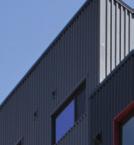
















Developers build ‘workforce’ housing to serve Nashville’s median
















BY HANNAH HERNER I Rutledge Flats
t’s housing for re ghters, teachers, baristas, artists — a common refrain when describing “workforce housing.”
In Nashville, several area developers are aiming for that group: people who are employed but are miles from the 1 percent. With high construction costs and high demand for units, area developers solve the equation for how to serve the growing middle while still serving their bottom line.
Ask seven area developers how they de ne workforce housing, and you will get seven different answers, but a useful metric is area median income. e numbers are set by the U.S. Department of Housing and Urban Development for each city yearly.
is year, the median income for a family of four in Davidson County is $106,000. is means if a family of four earns 80 percent of the AMI ($85,500 or less), they can qualify for a ordable housing units. For an individual, it would be $59,850 or less to qualify. For reference, most people who live in public housing make 30 percent of the AMI or less.
Holladay Ventures, among other rms, relies on HUD’s Low-Income Housing Tax Credit program. Using this program, the federal government pays for about 40 percent of construction costs, but requires that future tenants make an average of 60 percent of the AMI, with the ceiling at 80 percent AMI.
e Low-Income Housing Tax Credit is the key to building new a ordable units, but it has its limits, says Evan Holladay, president and CEO of Holladay Ventures.




“Without the credit, we wouldn’t be able to do what we’re doing, so we have to be able to t what the program requires,” he says. “It makes it in nitely harder to nance when you have non-tax credit qualifying units.”
e federal government doesn’t incentivize truly workforce housing, Holladay says, which he de nes as serving the 80-120 AMI mark. Some cities have a middle-income housing tax credit, or tax abatements for this group. Locally, the Barnes A ordable Housing Trust Fund tops out at people making 60 percent or less of the area median income for rental developments.
“As a housing advocate, and someone who deeply cares about a ordable housing and having housing choice and housing for all, that is the tough part,” he says. “What do we do when there’s no nancial support, and there’s no nancial incentive to do any 80 to 120 [AMI] units?”
Nashville’s Hastings architecture rm, with vision from Eagle Rock Ventures in Seattle, uses a congregate or co-housing model to keep its units attainable. At Rutledge Flats in SoBro or Martin Flats in Wedgewood-Houston, the only o ering is furnished studio units, which cost about $1,100 to $1,300 per month and include utilities. Residents share kitchens and laundry onsite.
Martin Flats has some parking, while Rutledge has no parking, relying on residents to use public transportation, walk, bike, or park o site. is philosophy allows the company to use a tiny site that may typically get overlooked, and therefore costs less.
“What we love about these projects the most is they’re providing for a need,” says David Powell, principal at Hastings. “In particular, here in


Nashville, it’s this workforce need that we are desperate for right now. But we’re doing it with dignity. We’re doing it by providing design and amenities and spaces that encourage community and interaction and collaboration without sacri cing the level of nishes and color.”
Another way to make workforce housing feasible is ipping old run-down hotel rooms — at least California- and Nashville-split rm Brick and Mortar Investments thinks so. e rm recently nished Trinity Lofts on Brick Church Pike.
Brick and Mortar accepts housing choice vouchers that subsidize rent, but the bread and butter of its tenants are individuals who may not qualify for paid-for a ordable housing under HUD, says Justin Novakovich, partner at Brick and Mortar. e rent is around $949 for a studio apartment with shared laundry.
Novakovich says the company was able to get low-interest nancing with low-interest debt to perform the renovations, but didn’t take funding streams beyond bank loans and investor funds. He says the company’s investors realize it will take years for renovation but are con dent the project will pay out because its central location means it will be valuable in the future.
“All of the new development around Nashville is luxury housing,” Novakovich says. “It’s so expensive to build that if you can’t charge $2,000 for a one-bedroom unit, you’re not going to make money, you’re going to lose money. We had to do it in a way that was not costprohibitive and could provide housing for this segment of the market at a reasonable rate.”
Sometimes the development work is
mission-driven, as is the case with both Metro Development Housing Authority and Urban Housing Solutions.
MDHA’s Cayce Transformation (formerly known as Envision Cayce) has brought online 87 out of 603 units aimed at its definition of workforce housing: 80 to 120 AMI. That’s in line with Rutledge and Martin Flats, with a price of $1,050 to $1,365 for a one-bedroom.
MDHA does not need to get returns to investors like a private developer might. A perk of the true mixed-income development MDHA offers is that if people begin making more than 120 percent of the AMI, they can still stay in the unit. The units are identical regardless of the
tenant’s income.
“As we’re putting the financing for these developments together, we’re really intentional about sizing the financing at the beginning so that we can charge these lower rents, particularly for the workforce units, because there isn’t really a systemic program to subsidize the development and operation of those, like there is for affordable housing,” says Curtis Thomas, MDHA director of planning and development.
Urban Housing Solutions was founded on helping people transition out of homelessness and offering permanent supportive housing for those with mental health struggles. However, over the past several years, it has seen growth in
ai17260681539_SV Boom September - printers marks.pdf 1 9/11/2024 10:22:37 AM

the need for higher income levels. One example is The Skyliner on Dickerson Pike, which serves people up to 100 percent of AMI.
“Now unfortunately affordability is so far out of reach for so many people that it has really grown, which is where we started to see this terminology like workforce housing or attainable housing,” says Olivia Jiménez, community development specialist at Urban Housing Solutions.
Whether it’s out of the kindness of their hearts or not, developers will see demand for workforce units, while luxury developers offer concessions to get tenants. If you build housing for the middle, it seems, they will fill it.




A full-service real estate company, Southeast Venture delivers development, brokerage, property management, and design services. Our client relationships are at the core of every project, driving success.


Increase in popularity of paddle sport means more courts, clubs BY LOGAN BUTTS
espite its ongoing status as the country’s premier up-and-coming sport, pickleball has been around longer than you think.
Originating in the 1960s, the paddle sport mainly operated in hubs on the West Coast and Florida for decades. That changed during the COVID-19 pandemic when pickleball saw an explosion in popularity nationwide as Americans were looking for ways to get out of the house and socialize safely. What was once considered a quirky hybrid of tennis and badminton became the country’s fastest-growing sport for three consecutive years, largely because of how accessible it is for players of all ages and skill sets.
But an explosion in popularity also brings a need for space. As tennis and pickleball players spar over court usage and developers struggle to find adaptable land, space has become the most crucial ingredient to pickleball’s continued growth.
“We would love to grow the sport, help facilitate that, help build community, because this area has seen such a massive influx of people from all across the country, and pickleball builds community unlike any other sport we’ve ever seen,” says Jesse DeMund, co-owner along with his wife Emily, of the franchise and development rights of Pickleball Kingdom in Tennessee.
“But there’s just very few places to play out here.”
Pickleball Kingdom, which has six Middle Tennessee locations in active development, is one of a slew of businesses capitalizing on the sport’s current boom economy. This summer alone, the likes of Pickleball Kingdom and The Picklr have established footholds in the Nashville area. Clubs like Music City Pickleball and Dinkville have thousands of members. Venues like the Gordon Jewish Community in Belle Meade and the Centennial Sportsplex are overrun with wait lines. Even Nashville Yards, the Gulch’s splashy outdoor real estate project, has allotted space for six pickleball courts.
“It’s almost like, no matter how fast we build these locations, with 14 courts and each club capping out at around 1,500 to 2,000 members, it’s like you can’t build these courts fast enough,” DeMund says.
“We try to take over previous infrastructure, so existing commercial real estate buildings that were former either retail or light industrial. Anywhere where we can find 30,000
square feet that’s accessible in good areas with existing pickleball communities that have the proper ceiling height and column spacing. So we’re kind of looking for a needle in a haystack in this area, but we’re finding them.”
“Eatertainment” ventures like Crush Yard are jumping into the fray locally hoping to become the Topgolf of the pickleball explosion.
“I actually think there’s going be a really interesting, symbiotic relationship between our model and theirs,” DeMund says.
“Topgolf was a really amazing feeder program for actual golf courses in the golfing industry. People are going to go have a fun date night and say, ‘Now I want to either join leagues or learn and take lessons.’”
With locations on the way in Nashville, Hendersonville, Mt. Juliet and Murfreesboro, as well as across the state in cities like Memphis and Chattanooga, Pickleball Kingdom is hoping to build a strong footprint as the sport’s popularity continues to explode in Tennessee. Competition will be fierce, as space is a premium. But not too fierce; that would go against the easygoing nature of the pickleball community.
“We have heard this time and time again where people were like, ‘I’ve had the same friends for 30 years, and I started playing pickleball, and now I have a whole new friend group,’” DeMund says. “It’s just it’s one of those sports that brings people together because of the way it’s played.”


